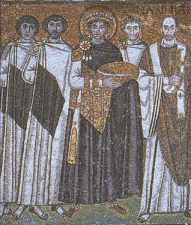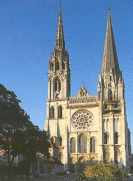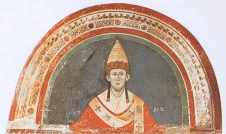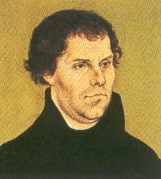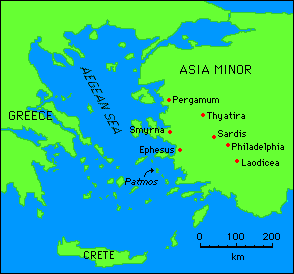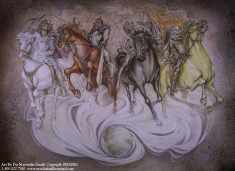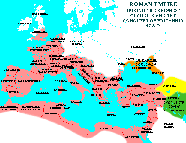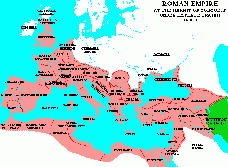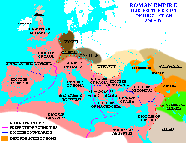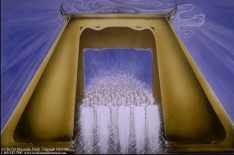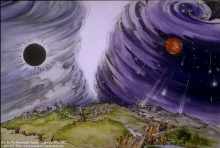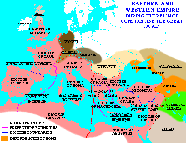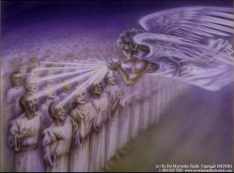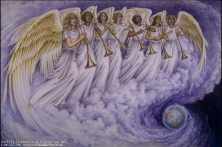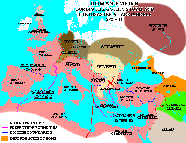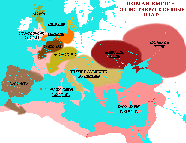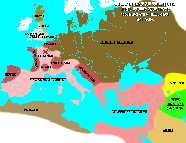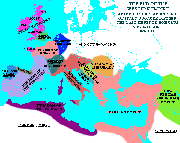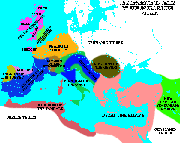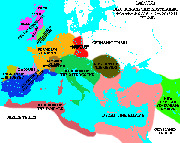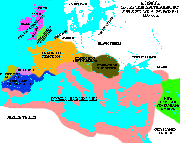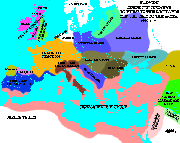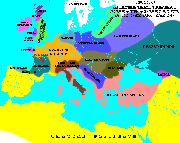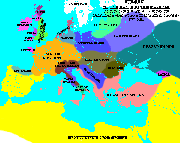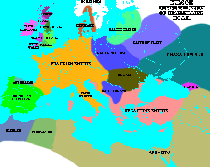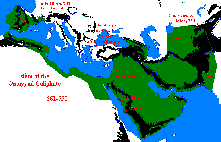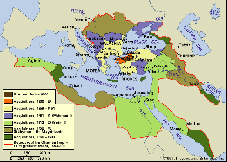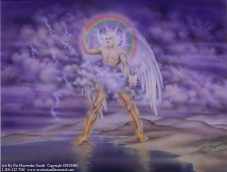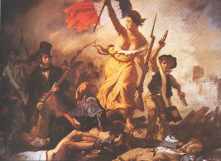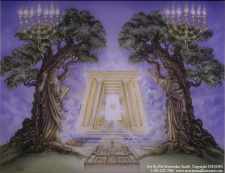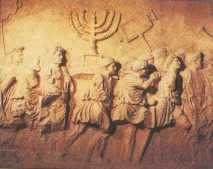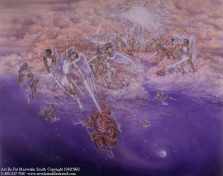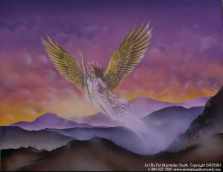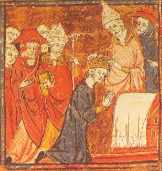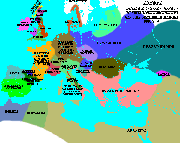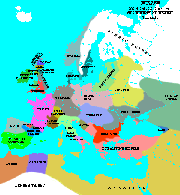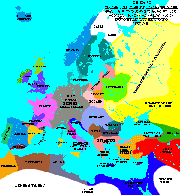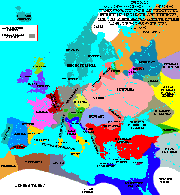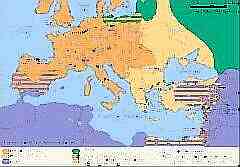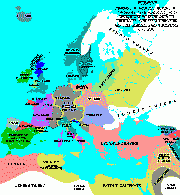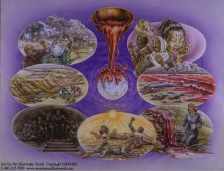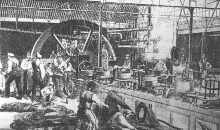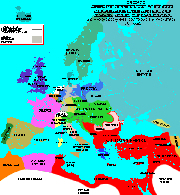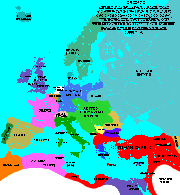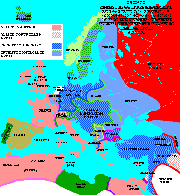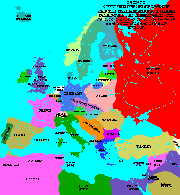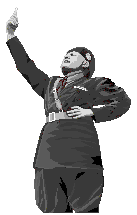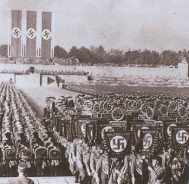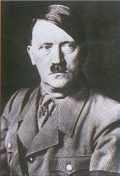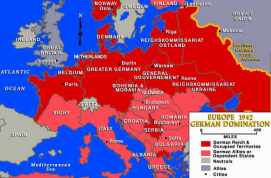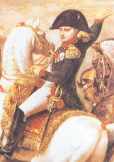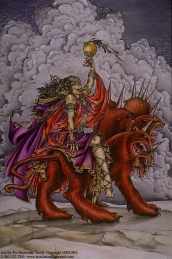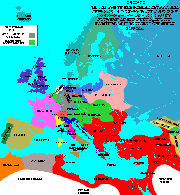
APOCALYPSE
The Historicist Intepretation
This website is of  Hellenic
authorship.
Hellenic
authorship.
|
This study demonstrates that
all of AD History can be found encoded in the prophetic verses of Revelation. |
Most people view the Apocalypse
of John as a prophecy about some terrifying events that will take place
sometime in the future. The present study intends to show that this view is not
correct. Through the use of a relatively unknown method of interpretation,
during the course of a verse-by-verse analysis, it will be demonstrated that the Apocalypse
is in fact a History book, written in symbolic language, and dealing with that
part of History that was still future when the book was written. Here are the Revelations
that were given to us almost two thousand years ago:
|
revelation historicist historicism
interpretation 666 lateinos historicist explanation of revelation historicist
view of prophecy adolph hitler adolf hitler napoleon benito mussolini third
reich holy roman empire the second coming of jesus christ prophecies
apocalyptic bible prophecy biblical prophecy papacy antichrist revelation 533
1793 roman catholic church laodicea thyatira sardis smyrna
ephesus philadelphia eschatology pergamum
pergamos beast with seven heads and ten horns praeterist preterist false
prophet ufo rapture tribulation millennialism millennial millennium rome
luther protestant christian historicist abaddon apollyon
|
![]() Chapter 1 is an
introduction to the book, showing Christ presenting Himself to John.
Chapter 1 is an
introduction to the book, showing Christ presenting Himself to John.
![]() Chapters 2 and 3: An overview
of Church History (The Seven Churches)
Chapters 2 and 3: An overview
of Church History (The Seven Churches)
![]() Chapters 4 and 5 set the
stage for what is about to follow.
Chapters 4 and 5 set the
stage for what is about to follow.
![]() Chapter 6: The Roman Empire in decline (The Seven
Seals and the Four Horsemen)
Chapter 6: The Roman Empire in decline (The Seven
Seals and the Four Horsemen)
![]() Chapter 7: The spread of Christianity (The 144,000
chosen ones)
Chapter 7: The spread of Christianity (The 144,000
chosen ones)
![]() Chapter 8: Fall of the Western Roman Empire (The first four
Trumpets)
Chapter 8: Fall of the Western Roman Empire (The first four
Trumpets)
![]() Chapter 9: The rise of Islam; fall of the Byzantine Empire (Fifth and
sixth Trumpet)
Chapter 9: The rise of Islam; fall of the Byzantine Empire (Fifth and
sixth Trumpet)
![]() Chapter 10: The Protestant Reformation (The Angel with
the Little Book)
Chapter 10: The Protestant Reformation (The Angel with
the Little Book)
![]() Chapter 11: The French Revolution (The death and
resurrection of the Two Witnesses)
Chapter 11: The French Revolution (The death and
resurrection of the Two Witnesses)
![]() Chapter 12: The Christian Persecutions (The Woman and
the Dragon)
Chapter 12: The Christian Persecutions (The Woman and
the Dragon)
![]() Chapter 13: The 1260 years of Papal dominance (The two Beasts
and the number 666)
Chapter 13: The 1260 years of Papal dominance (The two Beasts
and the number 666)
![]() Chapters 14 and 15 prepare
us for the description of the events of chapter 16.
Chapters 14 and 15 prepare
us for the description of the events of chapter 16.
![]() Chapter 16: Events of the last 200 years: (The Seven Vials)
Chapter 16: Events of the last 200 years: (The Seven Vials)
![]() The gradual diminution of Papal temporal power (The first five
Vials)
The gradual diminution of Papal temporal power (The first five
Vials)
![]() The return of the Jews to Palestine (Sixth Vial)
The return of the Jews to Palestine (Sixth Vial)
![]() Fascism and Nazism (Unclean spirits like frogs)
Fascism and Nazism (Unclean spirits like frogs)
![]() World War II and the Jewish Holocaust (The Battle of
Armageddon)
World War II and the Jewish Holocaust (The Battle of
Armageddon)
![]() Events still future (Seventh Vial)
Events still future (Seventh Vial)
![]() Chapter 17:
The Napoleonic Era (The woman
Babylon and the scarlet Beast)
Chapter 17:
The Napoleonic Era (The woman
Babylon and the scarlet Beast)
![]() Chapter 18
"laments" the punishment of Babylon, the false Church, while chapter
19 recapitulates what has happened so far, after having celebrated the arrival
of the true Church, or Bride of Christ. The latter, also named New Jerusalem,
is described in detail in chapters 21 and 22, while chapter 20 probably refers
to a distant future attack against this glorious City, a thousand years after
her arrival.
Chapter 18
"laments" the punishment of Babylon, the false Church, while chapter
19 recapitulates what has happened so far, after having celebrated the arrival
of the true Church, or Bride of Christ. The latter, also named New Jerusalem,
is described in detail in chapters 21 and 22, while chapter 20 probably refers
to a distant future attack against this glorious City, a thousand years after
her arrival.
![]() Summary and Conclusions: If you are
in a hurry, then this is the link for you!
Summary and Conclusions: If you are
in a hurry, then this is the link for you!
|
atlantis lemuria mahabharata love light |
Chapters 2
and 3: The Church through the ages
The early Church
In chapter 1, Jesus
Christ presented Himself to John, who is in exile on the Greek island of
Patmos. He has just asked him to write in a book everything he is about to see,
and send copies of that book to seven of the Churches in Asia Minor. The first
Church is the one of Ephesus.
2:1
Unto the angel of the church of Ephesus write; These things saith he that
holdeth the seven stars in his right hand, who walketh in the midst of the
seven golden candlesticks;
In Greek,
"ephesis" means "a great desire", "a great
drive", especially when one is new at something and desires to learn more
about it and to become good at it. This corresponds to the Christian Church in
her early stages, during which she had the burden of spreading this new
teaching to all of the Roman world and beyond, and history tells us that those
first Christians were very enthusiastic about their mission.
2:2
I know thy works, and thy labour, and thy patience, and how thou canst not bear
them which are evil: and thou hast tried them which say they are apostles, and
are not, and hast found them liars:
2:3
And hast borne, and hast patience, and for my name's sake hast laboured, and
hast not fainted.
An evil person would not
want to be a member of this Church, because these Christians, at least during
the initial phases of the Church's existence, used to give all their
possessions to the Church and the poor. Even at times when this was not common
practice, there was no motive for an evil person to join the Christian
community, as the latter had little power and was often persecuted. In other
words, the early Church "could not bear them which are evil".
Enthusiasm was quickly
diminished, as Christians were disappointed that Jesus did not return during
the first century AD, as many had been expecting.
2:4
Nevertheless I have somewhat against thee, because thou hast left thy first
love.
2:5
Remember therefore from whence thou art fallen, and repent, and do the first
works; or else I will come unto thee quickly, and will remove thy candlestick
out of his place, except thou repent.
In those times, being the
leader of a Christian congregation meant that one had a cross to carry, since
there were continuous threats to the Christian community by the powers of the
old order.
2:6
But this thou hast, that thou hatest the deeds of the Nicolaitanes, which I
also hate.
In Greek,
"niko" means "I win" and "laos" is "the
people". So, the "Nicolaitanes" should mean those who try to win
the favour of the people and rule over them. As discussed above, those were
very few in the early Church. The local presbyters and bishops were truly
servants to their flocks, and did not, with some exceptions, seek to obtain
personal power. Such attitudes would have led to divisions and conflicts, and
the Church, still young and fragile, could not afford such phenomena, as they
would compromise her very existence.
And this completes the
description of the Church of Ephesus.
2:7
He that hath an ear, let him hear what the Spirit saith unto the churches; To
him that overcometh will I give to eat of the tree of life, which is in the
midst of the paradise of God.
The
persecuted Church
The next period of Church
History was characterized by massive persecutions against Christians, in
reaction to the growth of the new religion.
2:8
And unto the angel of the church in Smyrna write; These things saith the first
and the last, which was dead, and is alive;
"Smyrna" is
"myrrh", used to make a sacrifice pleasurable to God or the gods.
This Church suffered through many tribulations, and many times was she deprived
of her possessions, her buildings, and her right to worship God the way she
wanted. This was because she was growing rapidly and was becoming dangerous to
the existing order, so she had to be drastically dealt with. In times of
relative peace, though, there were many false Christians, usually presbyters or
bishops, seeking to obtain personal power. This was due, in part, to the growth
of the Christian movement, due to which the Christian communities were now
stronger and more self-sufficient. Their leaders thus gradually obtained more
power and influence. Consequently, a leading position in a Christian community
was now becoming more attractive to people seeking such power and influence,
evil people in most cases. This situation led to a loosening of the bonds
between local congregations. Rivalries thus appeared. Heresies flourished and
meaningless disputes took place, with dark motives in most cases.
2:9
I know thy works, and tribulation, and poverty, (but thou art rich) and I know
the blasphemy of them which say they are Jews, and are not, but are the
synagogue of Satan.
"Jews" is a metaphor for "Christians", since the latter are
the ones that are "truly circumcised". This metaphor can be found in
Paul's Epistles.
There were many persecutions, even from Nero's time, but the fiercest of all
was the one started by Diocletian in January 303. Churches were destroyed,
books were burnt, most Christian property was confiscated, and many Christians
martyred. In 304, it became obligatory by law that everyone should worship the
Graeco-Roman Pantheon only. After Diocletian's abdication in 305, the
persecution was continued mainly in the Eastern part of the Empire, where the
Christians were more numerous, but with a gradually decreasing severity. In
January 313, the Edict of Milan, which established freedom of worship, was
issued by Constantine. It was also decided that all confiscated Christian
property should be returned to Christians.
2:10
Fear none of those things which thou shalt suffer: behold, the devil shall cast
some of you into prison, that ye may be tried; and ye shall have tribulation
ten days: be thou faithful unto death, and I will give thee a crown of life.
From 303 to 313 ten years
can be counted (the actual persecution had ended before the start of the year
313, but, using the ancient way of estimating time, ten years can be counted
from 303 to 312). In the book of Ezekiel it is said that a prophetic
"day" corresponds to an actual year, so ten years are symbolized by
ten days.
2:11
He that hath an ear, let him hear what the Spirit saith unto the churches; He
that overcometh shall not be hurt of the second death.
The
Empire becomes Christian
Christianity was then
recognized and adopted by the Empire, for which the decisive event was Emperor
Constantine's favourable attitude towards it and later conversion to it.
Christianity gradually became the official religion of the Empire.
2:12
And to the angel of the church in Pergamos write; These things saith he which
hath the sharp sword with two edges;
"Pergamos" can be translated in Greek as "super-marriage", or "a marriage that is larger than proper". Religion was married to the State, and religious leaders often tried to obtain temporal power by forming alliances with temporal leaders. The dispute between Areianism and Orthodoxy was a clear example of this situation, where one side would use the temporal leaders to undermine the other side.
2:13
I know thy works, and where thou dwellest, even where Satan's seat is: and thou
holdest fast my name, and hast not denied my faith, even in those days wherein
Antipas was my faithful martyr, who was slain among you, where Satan dwelleth.
The Church was now seated on the throne of Satan, meaning that she had won the
battle against the ancient polytheistic religion. It can also mean that she had
become a friend of the Empire, which had been a bitter enemy of the Word of God
during the previous centuries. In chapter 12, it will be
shown that the term "Dragon" or "Satan" refers to the
powers that are hostile to the Word of God and are, in this case, embodied by
the religion of the Graeco-Roman Pantheon and its representatives.
"Antipas" is a composition of two Greek words, meaning "against
all", and referring to the persecutions, now in the past, where the
Christians had been opposing the whole of the old world order.
The
"Nicolaitanes" were flourishing during the era of Pergamos. Well
known are the fights between bishops for power. The Areian issue sparked much
dispute, and the battle over supremacy between the different Patriarchates
would ultimately lead to the great Schism of 1054 between Orthodoxy and
Catholicism, in essence present for many centuries before that time.
2:14 But I have a few things against thee, because thou hast
there them that hold the doctrine of Balaam, who taught Balac to cast a
stumblingblock before the children of Israel, to eat things sacrificed unto
idols, and to commit fornication.
2:15
So hast thou also them that hold the doctrine of the Nicolaitanes, which thing
I hate.
In what way are the
"Nicolaitanes" guilty of fornication and idol worship? The Apostle
Paul, in one of his Epistles, incites the believers not to be divided into
fractions and say "I am a follower of Paul" or "I am a follower
of Apollos", but that all should have a common leader, the Word of God. In
Paul's days, as has been shown above, such phenomena of division were not the
rule. But, as the Christian communities grew stronger and larger, being the
leader of such a community became increasingly associated with temporal power.
As a result, divisions arose, and the situation described by Paul was now
becoming more and more common. Paul said that, when one views oneself as a follower
of Paul or Apollos, one forgets about Christ. The Church is symbolically said
to be the Bride of Christ, because she is supposed to have the Word of God
inside her. But, if the Church forgets about the Word of God, or Christ, and
follows other leaders, she commits adultery against Him. And this is why the
"Nicolaitanes" (meaning, as discussed above, those who try to win the
favour of the people and rule over them), much like Balaam and Balac, were
leading the "children of Israel", in this case symbolizing the
members of the Church, to commit fornication. Idol worship is the worship of
something other than the true God, so the act of following leaders other than
the Word of God is, indeed, a form of idol worship.
2:16
Repent; or else I will come unto thee quickly, and will fight against them with
the sword of my mouth.
And that was the situation of things in the centuries after Emperor
Constantine's time.
2:17
He that hath an ear, let him hear what the Spirit saith unto the churches; To
him that overcometh will I give to eat of the hidden manna, and will give him a
white stone, and in the stone a new name written, which no man knoweth saving
he that receiveth it.
The
Church in the West
Incited by the Bishopric of Rome and forced by the circumstances, the Church in
the West slowly separated herself from her Eastern counterpart.
2:18
And unto the angel of the church in Thyatira write; These things saith the Son
of God, who hath his eyes like unto a flame of fire, and his feet are like fine
brass;
Contrarily to what was going on in the East, the West was in turmoil after the
invasions and settlement of mostly Germanic tribes. The Catholic Church
undertook the great work of keeping both religion and knowledge alive, mainly
through her numerous monasteries, and she also spread the Word of God to
Britain, Germany, Scandinavia, the Baltic regions, Poland, Bohemia, Moravia,
Hungary, etc.
2:19
I know thy works, and charity, and service, and faith, and thy patience, and
thy works; and the last to be more than the first.
I can't say for sure whether "Thyatira" (or, rather,
"Thyateira") means something, but, through a (not very satisfactory)
play of (half) words, it could mean "sacrifice to the Empress". The
Empress would be the Church of Rome, here named "the woman Jezebel",
who fell into the error of the Nicolaitanes and demanded to be worshipped
herself, instead of teaching her flock to worship the Lord only. She had once
been the Church of Christ, but now she was the Church of Rome; she was not Christ's
anymore. In other words, she had committed adultery against her Husband. To
follow the Roman Pontiff instead of the Christ is an obvious form of adultery
and idol worship. "Jezebel", many centuries later, as history tells
us, would be deprived of most of her power, and the results of her
"fornication" would disappear from the face of the earth.
"Thyatira", through another unsatisfactory play of (half) words,
could mean "the sacrifice of the Latins".
2:20 Notwithstanding I have a few things against thee, because
thou sufferest that woman Jezebel, which calleth herself a prophetess, to teach
and to seduce my servants to commit fornication, and to eat things sacrificed
unto idols.
2:21
And I gave her space to repent of her fornication; and she repented not.
2:22
Behold, I will cast her into a bed, and them that commit adultery with her into
great tribulation, except they repent of their deeds.
2:23
And I will kill her children with death; and all the churches shall know that I
am he which searcheth the reins and hearts: and I will give unto every one of
you according to your works.
In the Greek text, verse
2:20 reads: "because thou sufferest thy woman Jezebel...",
meaning that Jezebel is in Thyatira, and the interpretation is that the
Church of Rome is a part of the whole Western Church. That part would
ultimately gain control of the entire Western Church and completely sever her
off from her Eastern sister, while placing her own glory above the glory of
Christ throughout the whole Western world.
But, apart from those who were promoting the Pontiff's supremacy, the Catholics
throughout Europe were, at that time, as mentioned above, engaged in great
works.
2:24
But unto you I say, and unto the rest in Thyatira, as many as have not this
doctrine, and which have not known the depths of Satan, as they speak; I will
put upon you none other burden.
2:25
But that which ye have already hold fast till I come.
These works would prove to be fundamental contributions to the waking up of
Europe after the Dark Ages.
2:26
And he that overcometh, and keepeth my works unto the end, to him will I give
power over the nations:
2:27
And he shall rule them with a rod of iron; as the vessels of a potter shall
they be broken to shivers: even as I received of my Father.
2:28
And I will give him the morning star.
2:29
He that hath an ear, let him hear what the Spirit saith unto the churches.
The Catholic Church, over the centuries, mutated into a veritable theocracy,
where the Pope of Rome was the supreme ruler, the representative of Christ on
earth, whose authority was not to be questioned.
There were no more pagans left to evangelize, so the missionary spirit
gradually died down. This is the age of the Inquisition, first established in
Toulouse, France, in 1233. It is the age of the abominable Indulgences
(forgiveness of sins by the Pope in exchange for money) and of a worldly and
corrupted Church, resistant to change and progress. Great campaigns for the
silencing of those who disagreed with the Church took place, like the
persecution of the Albigenses, the Waldenses and the Hussites, leading to
innumerable martyrdoms of true Christian believers. That Church, sadly, no
longer had the life-giving Spirit of Christ in her.
3:1
And unto the angel of the church in Sardis write; These things saith he that
hath the seven Spirits of God, and the seven stars; I know thy works, that thou
hast a name that thou livest, and art dead.
Sardis (or, rather, Sardeis) had been, for a time, the ancient Persian capital,
and it was well known for its riches. The Roman Catholic Church did in fact
accumulate vast riches during this time, augmented by the later colonization of
overseas territories by Catholic countries. The Church did not seem interested
in spreading the Word of God anymore, except to the aforementioned colonies,
the crimes committed against which are much better known than their
evangelization by the explorers/conquerors.
3:2
Be watchful, and strengthen the things which remain, that are ready to die: for
I have not found thy works perfect before God.
3:3
Remember therefore how thou hast received and heard, and hold fast, and repent.
If therefore thou shalt not watch, I will come on thee as a thief, and thou
shalt not know what hour I will come upon thee.
It should be stressed, though, that quite a few clergymen and a large number of
ordinary people were still faithful to Christ, even though they were
outnumbered by those who, out of convenience or ignorance, were worshipping
Rome instead of Him.
3:4
Thou hast a few names even in Sardis which have not defiled their garments; and
they shall walk with me in white: for they are worthy.
3:5
He that overcometh, the same shall be clothed in white raiment; and I will not
blot out his name out of the book of life, but I will confess his name before
my Father, and before his angels.
3:6
He that hath an ear, let him hear what the Spirit saith unto the churches.
The
enlightened Church
But eventually the human mind woke up. The Renaissance began, and a new
understanding of the Word of God was sought, mainly through the Protestant
Reformation. New doors were opened to the human mind.
3:7
And to the angel of the church in Philadelphia write; These things saith he
that is holy, he that is true, he that hath the key of David, he that openeth,
and no man shutteth; and shutteth, and no man openeth;
"Philadelphia" (yes, the Greek spelling is "Philadelpheia")
means "to love one's brothers", and Christians once again became
brothers during this era. The Bible was now available for everyone to read, not
imprisoned in dead languages. The Church now had little temporal power, but she
was a much more real Church than in the previous centuries. This was true for
the Catholic countries as well, after the Church lost much of her temporal
power in those countries.
3:8
I know thy works: behold, I have set before thee an open door, and no man can
shut it: for thou hast a little strength, and hast kept my word, and hast not
denied my name.
In many countries, Roman Catholics converted to Protestantism, abandoning the
sterile teachings of Rome to embrace this new understanding of religion, which
re-discovered the Scriptures and made them available to the people. Catholicism
itself was renewed through the Counter-Reformation, which, although led by the
controversial Jesuit order, gave emphasis to education and revived the
missionary spirit. The so-called Christians of the Dark and Middle Ages thus
slowly evolved into truer Christians.
3:9
Behold, I will make them of the synagogue of Satan, which say they are Jews,
and are not, but do lie; behold, I will make them to come and worship before
thy feet, and to know that I have loved thee.
This renewed Christian fervour lasted for a few centuries, and then it died
down, mainly because of the scientific and technological progress and the great
increase in wealth ("temptation") which characterizes the present
era.
3:10
Because thou hast kept the word of my patience, I also will keep thee from the
hour of temptation, which shall come upon all the world, to try them that dwell
upon the earth.
The Church would never again be as alive as in the time of the Church of
Philadelphia.
3:11
Behold, I come quickly: hold that fast which thou hast, that no man take thy crown.
3:12
Him that overcometh will I make a pillar in the temple of my God, and he shall
go no more out: and I will write upon him the name of my God, and the name of
the city of my God, which is new Jerusalem, which cometh down out of heaven
from my God: and I will write upon him my new name.
3:13
He that hath an ear, let him hear what the Spirit saith unto the churches.
Let's take a look at the Church of the present day.
3:14
And unto the angel of the church of the Laodiceans write; These things saith
the Amen, the faithful and true witness, the beginning of the creation of God;
"Laodicea" (Laodiceia) means "the judgment of the people"
or "the judgment by the people". If the first one is correct, it
could mean that there is to be some kind of "judgment" during or
immediately after the "reign" of this Church. Anyhow, this Church is
characterized by spiritual indifference. Not rejection of religion, like in the
French or Russian Revolutions, which at least shows that one is spiritually
awake, but indifference, which shows spiritual staleness.
3:15
I know thy works, that thou art neither cold nor hot: I would thou wert cold or
hot.
3:16
So then because thou art lukewarm, and neither cold nor hot, I will spue thee
out of my mouth.
In this day, we have become dependent on material things, and have forgotten
about the world of the mind and spirit. We do not strive to fill ourselves with
spiritual virtues, but to fill our houses with material possessions instead.
3:17
Because thou sayest, I am rich, and increased with goods, and have need of
nothing; and knowest not that thou art wretched, and miserable, and poor, and
blind, and naked:
The way out of this error is not through the deprivation of material goods, but
through the accumulation of spiritual knowledge. These are dangerous times we
are living in, and only through the cultivation of the mind and spirit can we
make good use of our age's material prosperity.
3:18
I counsel thee to buy of me gold tried in the fire, that thou mayest be rich;
and white raiment, that thou mayest be clothed, and that the shame of thy
nakedness do not appear; and anoint thine eyes with eyesalve, that thou mayest
see.
Our thirst for material goods has led, in this era, to the greatest catastrophes
humankind has ever known, including the destruction of the environment. I
believe that, having learned much from these catastrophes, we are slowly
beginning to emerge out of this spiritual hibernation.
3:19
As many as I love, I rebuke and chasten: be zealous therefore, and repent.
3:20
Behold, I stand at the door, and knock: if any man hear my voice, and open the
door, I will come in to him, and will sup with him, and he with me.
3:21
To him that overcometh will I grant to sit with me in my throne, even as I also
overcame, and am set down with my Father in his throne.
This analysis may seem arbitrary to some, but I can't help but observe that
there are striking similarities between the Seven Churches and the outline of
actual Church History. Jesus asks us to hear with our spiritual, and not
literal, ears, meaning that He wants us to understand a hidden meaning behind
these messages to the Seven Churches. Throughout the Apocalypse, a group of
seven things denotes a chronological sequence of events or situations with a
common theme. Seven also denotes totality. Thus, the Seven Churches must
symbolize the course of the Church throughout history.
3:22
He that hath an ear, let him hear what the Spirit saith unto the churches.
|
|
Chapter 1 | 2
| 3 | 4 | 5 | 6 | 7 | 8 | 9 | 10 | 11 | 12 | 13 | 14 | 15
| 16 | 17 | 18 | 19 | 20 | 21 | 22
Chapter 6: Decline
of the Roman Empire - Triumph of Christianity
In chapter 5, a book with seven seals is presented to John. He is told that no
one can break the seals and open the book, except Jesus Christ. John then sees
a Lamb with seven eyes (all-knowing) and seven horns (all-powerful). In chapter
6, the Lamb breaks the seals and opens the book. World History thus begins to
unfold before our eyes, starting with the decades after the lifetime of Jesus.
6:1
And I saw when the Lamb opened one of the seals, and I heard, as it were the
noise of thunder, one of the four beasts saying, Come and see.
The winning years of the Empire
The Roman Empire was in peak strength for a long time after Jesus' lifetime.
Until the end of the second century AD, there was political stability, strong
and long-lasting emperors, peace (the Pax Romana) and prosperity. The borders
of the Empire were expanding.
6:2
And I saw, and behold a white horse: and he that sat on him had a bow; and a
crown was given unto him: and he went forth conquering, and to conquer.
The map on the left shows the Empire in the year 47 AD, while the one on the
right shows what the Empire looked like in 116 AD, at the height of conquest,
under Emperor Trajan:
Decline
sets in
But then disorder arised, and the emperors started succeeding each other very
quickly, usually through assassinations and civil wars. In the third century
AD, rarely did any emperor rule for more than five years, and they were usually
assassinated or killed in battle. Large parts of the Empire declared their
independence, led by renegade army commanders or local chiefs.
6:3
And when he had opened the second seal, I heard the second beast say, Come and
see.
6:4
And there went out another horse that was red: and power was given to him that
sat thereon to take peace from the earth, and that they should kill one
another: and there was given unto him a great sword.
This is what the Empire looked like in 260, after the establishment of a
renegade "Gallic Empire":
And in 268, after the creation of an independent "Palmyrenic Kingdom"
on the Asian shores:
This disorder caused, inevitably, an economic meltdown. Food became scarce, and
increasingly expensive, the fields were not adequately cultivated and foreign
invaders started making incursions into the Empire, contributing to the
disaster.
6:5
And when he had opened the third seal, I heard the third beast say, Come and
see. And I beheld, and lo a black horse; and he that sat on him had a pair of
balances in his hand.
6:6
And I heard a voice in the midst of the four beasts say, A measure of wheat for
a penny, and three measures of barley for a penny; and see thou hurt not the
oil and the wine.
Plague, famine, and a drop in the standards of living were inevitable
companions to this unfortunate situation. The bubonic plague, and other
calamities, killed a large part of the population, possibly amounting to
one-fourth of the Empire's inhabitants.
6:7
And when he had opened the fourth seal, I heard the voice of the fourth beast
say, Come and see.
6:8
And I looked, and behold a pale horse: and his name that sat on him was Death,
and Hell followed with him. And power was given unto them over the fourth part
of the earth, to kill with sword, and with hunger, and with death, and with the
beasts of the earth.
The Persecution of Diocletian
But Rome would not go down that easily. Outside and inside enemies were finally
dealt with. The Empire regained its size:
To prevent renegade states from arising, the provinces of the Empire were
re-organized into larger regions, called Dioceses, by the Emperor Diocletian
(Vladimir Putin recently did the same thing with Russia). To make the
administrative system even more efficient, the Empire itself was divided into
Eastern and Western halves, each in turn divided into two parts:
The Christians were also felt to be an inside enemy of the Empire, so
Diocletian organized the fiercest of all persecutions against them, which
completed the series that had begun under Emperor Nero in the first
century.
6:9
And when he had opened the fifth seal, I saw under the altar the souls of them
that were slain for the word of God, and for the testimony which they held:
6:10
And they cried with a loud voice, saying, How long, O Lord, holy and true, dost
thou not judge and avenge our blood on them that dwell on the earth?
6:11
And white robes were given unto every one of them; and it was said unto them,
that they should rest yet for a little season, until their fellowservants also
and their brethren, that should be killed as they were, should be fulfilled.
A great "earthquake" followed, which means the collapsing of the old
world order and the creation of a new one. This was most evident under Emperor
Constantine, who adopted the sign of the Cross and made it possible for the new
religion to gradually become the official religion of the State. The
"light" of the old religion went out.
6:12
And I beheld when he had opened the sixth seal, and, lo, there was a great
earthquake; and the sun became black as sackcloth of hair, and the moon became
as blood;
During a solar eclipse,
the sun appears black, while during a lunar eclipse the moon does not appear
totally black, but assumes a dark reddish colour.
The priests and seers of the old religion were cast down from their former
position of power and glory.
6:13
And the stars of heaven fell unto the earth, even as a fig tree casteth her
untimely figs, when she is shaken of a mighty wind.
It was now time for the spiritual teachings of the old religion to depart,
giving their place to the Christian teachings. Spiritual, as well as civil,
power was taken from those adhering to the old religion and was transferred to
Christians.
6:14
And the heaven departed as a scroll when it is rolled together; and every
mountain and island were moved out of their places.
"Mountains" and "islands" denote prominence, thus probably
referring to high social positions, characterized by power and influence. Those
would, from now on, be occupied mostly by Christians, since Christianity would
be the official religion of the Empire. In a way, they "moved out of their
places".
What an unhappy time for those still following the old religion, rich and poor,
great and small, kings and slaves.
6:15
And the kings of the earth, and the great men, and the rich men, and the chief
captains, and the mighty men, and every bondman, and every free man, hid
themselves in the dens and in the rocks of the mountains;
The old religion was eventually persecuted into extinction.
6:16
And said to the mountains and rocks, Fall on us, and hide us from the face of
him that sitteth on the throne, and from the wrath of the Lamb:
6:17
For the great day of his wrath is come; and who shall be able to stand?
In the Apocalypse, every scene is seen from a specific point of view.
Afflictions are seen from the point of view of those who suffer through them,
in this case the followers of the ancient religion. The "heaven"
departed, and the "mountains" and "islands" moved out of
their places, but only as far as those people were concerned. As far as
Christians were concerned, there was a new "heaven", a Christian one,
and they were the new occupants of "mountains" and
"islands". But why isn't this scene seen from their point of view, as
well? After all, it's their victory. Well, that's what chapter 7 is here for.
Chapter 1 | 2
| 3 | 4 | 5 | 6 | 7 | 8 | 9 | 10 | 11 | 12 | 13 | 14 | 15
| 16 | 17 | 18 | 19 | 20 | 21 | 22
Chapter 7: The
spread of Christianity
A period of peace followed Constantine's rise to power. A series of strong
emperors helped preserve economic and political stability, and the threat of
the "barbarian" peoples was temporarily put under control. The
Emperor Julian, for example, a famous follower of the ancient religion, did a
great job driving the invaders out of Gaul.
7:1
And after these things I saw four angels standing on the four corners of the
earth, holding the four winds of the earth, that the wind should not blow on
the earth, nor on the sea, nor on any tree.
This is what the Empire looked like in 330, during the reign of Constantine,
enjoying its last peaceful moments:
During this time of relative peace and prosperity, the followers of
Christianity, the religion that had come from the East, were greatly
multiplied. A vast number of people received the "seal of the living
God", giving up their old faith.
7:2
And I saw another angel ascending from the east, having the seal of the living
God: and he cried with a loud voice to the four angels, to whom it was given to
hurt the earth and the sea,
7:3
Saying, Hurt not the earth, neither the sea, nor the trees, till we have sealed
the servants of our God in their foreheads.
The number of Christians can be symbolically said to be 144,000, which is 12
times 12 times 1000, which is explained as the 12 Apostles (the Rocks upon
which the Church is built), in a way "multiplying" themselves (12
times 12) through the spread of the Teaching, producing a large number of
believers ("times 1000").
7:4
And I heard the number of them which were sealed: and there were sealed an
hundred and forty and four thousand of all the tribes of the children of
Israel.
7:5
Of the tribe of Juda were sealed twelve thousand. Of the tribe of Reuben were
sealed twelve thousand. Of the tribe of Gad were sealed twelve thousand.
7:6
Of the tribe of Aser were sealed twelve thousand. Of the tribe of Nephthalim
were sealed twelve thousand. Of the tribe of Manasses were sealed twelve
thousand.
7:7
Of the tribe of Simeon were sealed twelve thousand. Of the tribe of Levi were
sealed twelve thousand. Of the tribe of Issachar were sealed twelve thousand.
7:8
Of the tribe of Zabulon were sealed twelve thousand. Of the tribe of Joseph
were sealed twelve thousand. Of the tribe of Benjamin were sealed twelve
thousand.
So the sacrifice of the multitudes slain during the great persecutions was not
in vain.
7:9
After this I beheld, and, lo, a great multitude, which no man could number, of
all nations, and kindreds, and people, and tongues, stood before the throne,
and before the Lamb, clothed with white robes, and palms in their hands;
7:10
And cried with a loud voice, saying, Salvation to our God which sitteth upon
the throne, and unto the Lamb.
And all the heavenly powers seem to be thankful for that.
7:11
And all the angels stood round about the throne, and about the elders and the
four beasts, and fell before the throne on their faces, and worshipped God,
7:12
Saying, Amen: Blessing, and glory, and wisdom, and thanksgiving, and honour,
and power, and might, be unto our God for ever and ever. Amen.
One of the "elders" of John's vision confirms that this multitude
comprises those sacrificed during the persecutions.
7:13
And one of the elders answered, saying unto me, What are these which are
arrayed in white robes? and whence came they?
7:14
And I said unto him, Sir, thou knowest. And he said to me, These are they which
came out of great tribulation, and have washed their robes, and made them white
in the blood of the Lamb.
From now on, Christianity would reign without interruption in a large part of
Europe, and, later on, of the whole world. The sacrifice of the generation of
martyrs had made it possible that their descendants be guided by the light of
the Christian, and not the ancient, religion. In the future, however, the Dark
Ages lay ahead, characterized by spiritual darkness and perversion of religion.
But this chapter deals with the hopes of this generation for a better future.
And, with patience and faith, the darkness of the next centuries would
eventually go away, and the Gospel, for which this generation had martyred,
would triumph.
7:15
Therefore are they before the throne of God, and serve him day and night in his
temple: and he that sitteth on the throne shall dwell among them.
7:16
They shall hunger no more, neither thirst any more; neither shall the sun light
on them, nor any heat.
7:17
For the Lamb which is in the midst of the throne shall feed them, and shall
lead them unto living fountains of waters: and God shall wipe away all tears
from their eyes.
Chapter 1 | 2
| 3 | 4 | 5 | 6 | 7 | 8 | 9 | 10 | 11 | 12 | 13 | 14 | 15
| 16 | 17 | 18 | 19 | 20 | 21 | 22
Chapter 8: Fall of
the Western Roman Empire
After the the Empire made peace with the Church and before the massive
"barbarian" invasions, there was relative peace, which spread to the
world of the spirit after the defeat of the Areian heresy. It proved
short-lived.
8:1
And when he had opened the seventh seal, there was silence in heaven about the
space of half an hour.
And then, "seven trumpets" began signaling the end of the Roman
Empire, first in the West, and then in the East.
8:2
And I saw the seven angels which stood before God; and to them were given seven
trumpets.
A new challenge began for Christians, that of protecting their religion and the
remnants of their civilization. The prayers of the saints were necessary.
8:3
And another angel came and stood at the altar, having a golden censer; and
there was given unto him much incense, that he should offer it with the prayers
of all saints upon the golden altar which was before the throne.
8:4
And the smoke of the incense, which came with the prayers of the saints,
ascended up before God out of the angel's hand.
From
that time on, great turmoil lay ahead, and huge crimes were to be committed.
The world order that was to emerge would only be crushed by the
"earthquake" of the French Revolution, many centuries later.
8:5
And the angel took the censer, and filled it with fire of the altar, and cast
it into the earth: and there were voices, and thunderings, and lightnings, and
an earthquake.
Let's follow history.
8:6
And the seven angels which had the seven trumpets prepared themselves to sound.
Germanic
peoples invade by land
The Eastern part of the Empire was invaded by the Visigoths in the late 4th
century:
But the Eastern Empire repelled the Visigoths. It was the West that would
eventually fall prey to the hands of the invaders. In the beginning of the 5th
century, the whole of the Western Empire was swept over by Goths, Franks,
Vandals, Alans, Sueves, Burgundians and other tribes. Rome was sacked by
Alaric, the leader of the Visigoths, in 410:
8:7
The first angel sounded, and there followed hail and fire mingled with blood,
and they were cast upon the earth: and the third part of trees was burnt up,
and all green grass was burnt up.
"Green grass" denotes prosperity. The "trees" must
symbolize centres of commerce and civilization; in other words, great cities,
like Rome, Constantinople, or Alexandria. The Empire was destroyed in three
distinct phases. This chapter deals with the first one, comprising the
"barbarian" invasions in the West. The next chapter
deals with the next two phases, the first one affecting mainly the areas of
Syria, Palestine and Egypt (advent of the Muslim Arabs in the 7th century) and
the second one affecting Asia Minor and the Balkan peninsula (the conquest of
which was completed by the Turks in 1453). Thus, the Roman Empire can be
schematically divided into three parts: 1. The Western part, with
Rome as its centre, 2. The core of the Greek world, comprising the
Balkan peninsula and Asia Minor, with Constantinople as its centre and 3. The Orient, under
Hellenistic influence, comprising Syria, Palestine and Egypt, with Alexandria
as its centre. Of the greatest cities, only Rome was sacked during this first
wave of invasions. That's why only one-third of the "trees" are burnt
up in this verse. Constantinople was not captured by the invaders, but the
Eastern part of the Empire was not left untouched by them. That's why all
"green grass" was burnt up. "Green grass" must symbolize
all of the small, organized communities in the Empire, all of which suffered
during those years. Commerce was adversely affected throughout the Empire, and
the economy went through rough times.
The Vandals, together with other peoples, crossed what is now known as the
strait of Gibraltar into North Africa and established their own maritime
kingdom in the Tyrrhenian Sea, and for some time they were rulers of the
western Mediterranean. They even sacked Rome in the middle of the 5th century.
8:8
And the second angel sounded, and as it were a great mountain burning with fire
was cast into the sea: and the third part of the sea became blood;
8:9
And the third part of the creatures which were in the sea, and had life, died;
and the third part of the ships were destroyed.
Attila
the Hun
In the middle of the 5th century, the Huns also terrorized the West for some
time. Their leader, Attila, is still remembered as a fearsome warrior and
conqueror. The rivers of Gaul and northern Italy were bloodied by the
destruction that he caused and by the wars made against him. He ultimately made
peace with Pope Leo I, and Rome was spared. The Huns were ultimately defeated
and their Empire was dissolved after Attila's sudden death.
8:10
And the third angel sounded, and there fell a great star from heaven, burning
as it were a lamp, and it fell upon the third part of the rivers, and upon the
fountains of waters;
8:11
And the name of the star is called Wormwood: and the third part of the waters
became wormwood; and many men died of the waters, because they were made
bitter.
This map shows the Hunnic Empire (dark brown) and its defeat:
The fall of Rome
Until the year 476, Rome had managed to resist subjugation. But her time came
in that year, when Odoacer, leader of the Heruli, subdued the former Capital of
the world. This is what the situation looked like immediately after the fall of
Rome:
The Ostrogoths occupied the Italian peninsula a few years later, led by
Theodoric, and the Ostrogothic Kingdom became the most prominent among the new
kingdoms for some time (notice also the growth of the Frankish Kingdom):
The Italian peninsula would be freed by Emperor Justinian a few decades
later,
...but only briefly. The Lombards, and then the Franks, would ultimately sever
the Italian peninsula off from Constantinople:
The Western Roman Empire was to exist no more after 476. In the West, the
lights of Roman civilization went out, and the Dark Ages lay ahead.
8:12
And the fourth angel sounded, and the third part of the sun was smitten, and
the third part of the moon, and the third part of the stars; so as the third
part of them was darkened, and the day shone not for a third part of it, and
the night likewise.
Great calamities were to strike the remainder of the Empire during the next
centuries, but that is another chapter.
8:13
And I beheld, and heard an angel flying through the midst of heaven, saying
with a loud voice, Woe, woe, woe, to the inhabiters of the earth by reason of
the other voices of the trumpet of the three angels, which are yet to sound!
Chapter 1 | 2
| 3 | 4 | 5 | 6 | 7 | 8 | 9 | 10 | 11 | 12 | 13 | 14 | 15
| 16 | 17 | 18 | 19 | 20 | 21 | 22
Chapter 9: Islam and
the Eastern Roman Empire
Mohammed
The next significant event after the fall of the Western Roman Empire was the
spread of Islam. It was founded by the "Prophet" Mohammed in the early
7th century.
9:1
And the fifth angel sounded, and I saw a star fall from heaven unto the earth:
and to him was given the key of the bottomless pit.
9:2
And he opened the bottomless pit; and there arose a smoke out of the pit, as
the smoke of a great furnace; and the sun and the air were darkened by reason
of the smoke of the pit.
The
Arabs
The Arab armies, guided by the spiritual teachings of the Prophet and the
Koran, went on to spread those teachings to the whole world.
9:3
And there came out of the smoke locusts upon the earth: and unto them was given
power, as the scorpions of the earth have power.
Their official purpose was not to conquer lands and plunder the wealth of the
cities, but to convert the "infidels", those who did not believe in
Allah and His Prophet.
9:4
And it was commanded them that they should not hurt the grass of the earth,
neither any green thing, neither any tree; but only those men which have not
the seal of God in their foreheads.
The Arabs' way of expanding their territory was not based on subjugation of
local populations. Instead, with the aid of the Koran, they assimilated the
people of the lands that they conquered. If they failed to convert the local
populations, they would annihilate them. The formerly Christian areas of Syria,
Palestine and Egypt, as well as all of North Africa and a large part of the
Iberian peninsula, gradually became Muslim, and only a small part of the population
remained Christian. Conversion to Islam was a painful process for the people
who lived in those religious times.
9:5
And to them it was given that they should not kill them, but that they should
be tormented five months: and their torment was as the torment of a scorpion,
when he striketh a man.
Mohammed started receiving his visions of the angel Gabriel in the year 610. In
the year 613 he started preaching his new religion. Shortly after that,
missions were sent to spread Islam to other lands. Mohammed assembled an army,
which eventually occupied all of Arabia and, in the 630's, reached the borders
of the Byzantine Empire. All of the cities of the Hellenistic world in the
Middle East, like Jerusalem, Antioch, Alexandria, etc., fell to the Muslims.
The Muslim armies were unstoppable; they swept through North Africa and
occupied the Iberian peninsula, reaching as far as southwestern France. This is
what the Arab Caliphate looked like in 750:
The Arabs were defeated for the first time by the Frankish King Charles Martel
in 732. In 750, the Abbasid dynasty came to power in Damascus, the Capital of
the Caliphate, replacing the Umayyad one. However, Umayyad rule continued in
the Iberian peninsula. In other words, after the year 750, the Caliphate was
divided. Around 762-3, the city of Baghdad was founded and was made Capital of
the new Abbasid Caliphate. The centre of gravity of the Caliphate thus moved
further away from Europe. After that time, relations between the Caliphate and
Christian Europe stabilized, and decline began to set in throughout the ever
dividing Arab world. This is what the Arab world looked like at the end of the
9th century:
From 613 to 763, 150 years passed, or five prophetic "months", each
comprising 30 years (according to the "day-year" principle of
Ezekiel). If we use the ancient way of counting (i.e. counting both the first
and last year and all in between), 150 years can be counted from 613 to 762.
The actual time of continuous Arabian expansion was a few decades shorter,
though, but, again according to the ancients' way of estimating time, a period
of, let's say, four months and a few days would be counted as five months.
The Arabs did not wish to spend energy on keeping subdued peoples from
revolting. The deal was "convert (and become one of us) or die". The
Christians did not want to convert to Islam, and they certainly did not want to
be killed by the Arab invaders. They wanted to keep their religion, even if
they had to live under Muslim occupation. But that was not possible.
9:6
And in those days shall men seek death, and shall not find it; and shall desire
to die, and death shall flee from them.
In this chapter,
"death" means subjugation.
The Arabs were famous for their cavalry; Arabian horses are admired for their
beauty and strength even today. Owing to their cavalry, they were conquering
one territory after the other and seemed invincible. They wore turbans and, even
though they were tough men, they had long hair.
9:7
And the shapes of the locusts were like unto horses prepared unto battle; and
on their heads were as it were crowns like gold, and their faces were as the
faces of men.
9:8
And they had hair as the hair of women, and their teeth were as the teeth of
lions.
9:9
And they had breastplates, as it were breastplates of iron; and the sound of
their wings was as the sound of chariots of many horses running to battle.
Their most fearsome weapon was not their swords, but the teachings of the
Koran, which gave them strength and courage to go on conquering, and helped
them assimilate the inhabitants of the territories that they invaded. So,
through these teachings, working their way into human minds slowly like poison,
and not through the swiftness of the sword, did the Arabs succeed in their
undertaking.
9:10
And they had tails like unto scorpions, and there were stings in their tails:
and their power was to hurt men five months.
They were led by the teachings of the Koran, which called for a conversion of
both Jews and Christians to Islam.
9:11 And they had a king over them, which is the angel of the
bottomless pit, whose name in the Hebrew tongue is Abaddon, but in the Greek
tongue hath his name Apollyon.
Islam proved destructive (Apollyon = destroyer) for both Jews and (mainly Greek
Orthodox) Christians. That's why the "angel of the bottomless pit"
has both a Greek and a Hebrew name. This is a point to remember for the analysis
of chapter 16.
And so ends the Arabian "plague". After 763, the Caliphate was
divided, was in decline, and never again gained the momentum it had before.
9:12
One woe is past; and, behold, there come two woes more hereafter.
The Eastern Roman, now Byzantine, Empire survived the advent of the Arabs, as
well as that of other invaders. But it was not to survive the invasion of
another fearsome people, the Turks.
9:13
And the sixth angel sounded, and I heard a voice from the four horns of the
golden altar which is before God,
9:14
Saying to the sixth angel which had the trumpet, Loose the four angels which
are bound in the great river Euphrates.
The tribe of the Seljuk Turks was founded by the warrior Seljuk, whose one son
and three nephews founded the Great Seljuk Empire, stretching through Persia
and Mesopotamia. In the late 1050's, the Caliph of Baghdad came under Seljuk
"protection". In the year 1063, the Turkish Sultan Toghrul-Begh,
Seljuk's nephew, died and was succeeded by his own nephew, Alp-Arslan. By 1064
the latter had crossed the Euphrates into the Empire. In 1067 he took the great
city of Caesarea, in 1068 he took Iconium and, in 1071, he won a decisive
victory at Mantzikert. From that day on, the Turks would cause Byzantine
borders to shrink until May 29th, 1453, when Constantinople fell to another
Turkish tribe, the Ottomans. The last "third" of the Empire was gone,
and the third and final stage of the Empire's destruction was complete. Here is
a map showing the Ottoman expansion:
9:15
And the four angels were loosed, which were prepared for an hour, and a day,
and a month, and a year, for to slay the third part of men.
From 1063 to 1453 there were 391 years, using the ancient way of counting. A
prophetic year (360 years) plus a prophetic month (30 years) plus a prophetic
day (1 year) plus a prophetic hour (1 month) is 391 years and one month. From
1064 to 1453, though, 390 years can be counted. It is reasonable, though, to
count from Alp-Arslan's ascension to power. I am also not sure about the exact
time the definitive invasion of the Empire began, but it was either in 1063 or
in 1064.
The Turks, in contrast to the Arabs, did not succeed in converting the
Christians of the territories that they occupied to Islam. The Greeks, the
Serbs, the Bulgarians, the Romanians and the Armenians were never assimilated
by the Turks. So the Turkish presence in these formerly Byzantine territories
was in fact an occupation force, and so it remained for many centuries, until
the aforementioned peoples fought for and gained their independence. This long
occupation is what is meant by the "slaying" of "the third part
of men". The Arabs, having assimilated the local populations, never had to
deal with such issues, and that's why it is said that they didn't engage in
"killing". Likewise, after the invasions in the West (chapter
8), the invaders didn't keep the old inhabitants of the Western Empire in
subjugation, but mingled with them, and that's why it is only said that a
"third" of the trees, grass, etc. were destroyed, but the "third
part of men" was not killed.
9:16
And the number of the army of the horsemen were two hundred thousand thousand:
and I heard the number of them.
The main Turkish groups responsible for the fall of the Eastern Roman Empire
were (1) the Seljuks and (2) the Ottomans. In the original Greek text, it says
"two myriads of myriads" and not "two hundred thousand
thousand". A myriad (10,000) of Turkish soldiers (a myriad is often
associated with an army, e.g. in Xenophon's "Descent of the 10,000"),
multiplied by itself, because of the soldiers' bravery and effectiveness (a
rather arbitrary move), produces 100,000,000 soldiers. If both Seljuks and
Ottomans are accounted for, we have 200,000,000 soldiers (symbolically). And
the Turks, like the Arabs, had a strong cavalry.
The Ottoman warriors wore mostly the colours red, blue and yellow ("fire,
jacinth and brimstone"). This can be clearly seen in many drawings dating
from Ottoman times. Here is a drawing of two Ottoman jenissaries and a military
officer:
The siege of Constantinople was one of the first battles in history in which
cannons and gunpowder were used (they had been used for the first time about a
century earlier).
9:17
And thus I saw the horses in the vision, and them that sat on them, having
breastplates of fire, and of jacinth, and brimstone: and the heads of the
horses were as the heads of lions; and out of their mouths issued fire and
smoke and brimstone.
Thus fell the last "third" of the Empire. The third and final stage
of the Empire's destruction was thus complete, the other two being the
invasions in the West and the Arab expansion.
9:18
By these three was the third part of men killed, by the fire, and by the smoke,
and by the brimstone, which issued out of their mouths.
But the Ottomans' power lay not only in their cannons, but in the Koran as
well. The Turks renewed the fervour for the spread of Islam, which had in the meantime
died down.
9:19
For their power is in their mouth, and in their tails: for their tails were
like unto serpents, and had heads, and with them they do hurt.
The rest of Europe remained pretty much Christian, but it was a far from
angelic Christianity. Pagan practices and superstitions were flourishing in the
Church (see also chapters 2 and
12
for more on the metaphorical "idol worship" in the Church), crimes
were being committed in the name of Christ and, most notably, spiritual
"whoredom" abounded in these far from enlightened times, as is
explained in the analysis of chapters 2
and 17.
9:20
And the rest of the men which were not killed by these plagues yet repented not
of the works of their hands, that they should not worship devils, and idols of
gold, and silver, and brass, and stone, and of wood: which neither can see, nor
hear, nor walk:
9:21
Neither repented they of their murders, nor of their sorceries, nor of their
fornication, nor of their thefts.
It was time for a
spiritual awakening.
Chapter 1 | 2
| 3 | 4 | 5 | 6 | 7 | 8 | 9 | 10 | 11 | 12 | 13 | 14 | 15
| 16 | 17 | 18 | 19 | 20 | 21 | 22
Chapter 10:
Renaissance and Reformation
After the Dark and Middle Ages, the time came for human consciousness to wake
up from its hibernation. It was the Renaissance, the beginning of an era of
light and knowledge, resembling a rainbow after a thunderstorm.
10:1
And I saw another mighty angel come down from heaven, clothed with a cloud: and
a rainbow was upon his head, and his face was as it were the sun, and his feet
as pillars of fire:
Influenced
by this awakening, and in reaction to the defiled Papal system, the Protestant
Reformation occurred, which, along with the invention of printing, led to the
"opening up" of the Bible, meaning its translation and broad
circulation. It had generally only been written in Latin (in Western Europe) up
to this time, and only a few copies existed, mainly in monasteries. The priests
had not really been teaching from the Bible until this time. This "opening
up" of the Bible would eventually spread itself even to the newly
discovered lands beyond the seas, to America, to Africa and to Oceania.
10:2
And he had in his hand a little book open: and he set his right foot upon the
sea, and his left foot on the earth,
This
current was, not surprisingly, met with strong resistance by the powers of the
old order, as they felt that it would undermine their influence on human minds.
Up to this time, they had been able to assert their authority due to the
illiteracy of the masses. They had been able to impose laws and practices whose
spirit had been contrary to the Bible, since the latter had not been available
to the people. But now, people began to think for themselves, and the Bible
became available for study. The flaws of the Papal system became evident to
those who did study the Scriptures, and the result was the Protestant
Reformation.
10:3
And cried with a loud voice, as when a lion roareth: and when he had cried,
seven thunders uttered their voices.
The
representatives of the old order fought hard, but they fought in vain. No
matter how hard they tried, they could not stop the awakening. The
"thunder" of their voices would go unheard. The time of the
thunderstorm had now ended and the rainbow had emerged.
10:4
And when the seven thunders had uttered their voices, I was about to write: and
I heard a voice from heaven saying unto me, Seal up those things which the
seven thunders uttered, and write them not.
It
was the beginning of the end for those who had exploited the name of Christ for
their own purposes. The main phase of their defeat, though, would take place
after the French Revolution, which, as we shall see, marks the sounding of the
"seventh Trumpet".
10:5
And the angel which I saw stand upon the sea and upon the earth lifted up his
hand to heaven,
10:6
And sware by him that liveth for ever and ever, who created heaven, and the
things that therein are, and the earth, and the things that therein are, and
the sea, and the things which are therein, that there should be time no longer:
10:7
But in the days of the voice of the seventh angel, when he shall begin to
sound, the mystery of God should be finished, as he hath declared to his
servants the prophets.
Let's get back to the theme of this chapter. What were the results of the
appearance of this new current?
10:8
And the voice which I heard from heaven spake unto me again, and said, Go and
take the little book which is open in the hand of the angel which standeth upon
the sea and upon the earth.
Many
people, a large percentage of the European population, accepted the Protestant
teaching eagerly. This is what the religious situation looked like in Europe
after the spread of Protestantism:
But it was not to be without grave consequences. Great wars broke out and
Europe was in turmoil for several centuries. Another result of Protestantism
was the development of German nationalism, which would, some centuries later,
lead to the greatest of wars.
10:9
And I went unto the angel, and said unto him, Give me the little book. And he
said unto me, Take it, and eat it up; and it shall make thy belly bitter, but
it shall be in thy mouth sweet as honey.
10:10
And I took the little book out of the angel's hand, and ate it up; and it was
in my mouth sweet as honey: and as soon as I had eaten it, my belly was bitter.
But,
ultimately, the new teaching was to be spread throughout the world.
10:11
And he said unto me, Thou must prophesy again before many peoples, and nations,
and tongues, and kings.
Chapter 1 | 2
| 3 | 4 | 5 | 6 | 7 | 8 | 9 | 10 | 11 | 12 | 13 | 14 | 15
| 16 | 17 | 18 | 19 | 20 | 21 | 22
Chapter 11: The
French Revolution
The
role of the Church is doubted
With the arrival of the age of Enlightenment, the Church received much
criticism. Her spiritual and political role was questioned. After centuries of
being in an undisputed leading position in the order of things, her time came
to be measured by the divine standards that she had used to measure others.
11:1
And there was given me a reed like unto a rod: and the angel stood, saying,
Rise, and measure the temple of God, and the altar, and them that worship
therein.
But most of those that were in control of the Church, those highest in the
Hierarchy, those who had strived for and obtained great temporal power, the
counterfeiters and oppressors of the true Christian Church, could not stand
before God. They were not even worth measuring, as they were strangers to the
Word of God.
11:2
But the court which is without the temple leave out, and measure it not; for it
is given unto the Gentiles: and the holy city shall they tread under foot forty
and two months.
The
Church is criticized for her past errors
They had silenced all opposing voices for many centuries, and had made war
against all those who had questioned their power. The true Word of God, written
in the Old and New Testaments (or Witnesses), had not been a central element in
the teachings of the Church until that time. After all, the Bible had only been
written in Latin, and only a few people understood that language. That way, the
leaders of the Church had been able to impose laws and practices not based on,
or even contrary to, the Bible.
11:3 And I will give power unto my two witnesses, and they shall
prophesy a thousand two hundred and threescore days, clothed in sackcloth.
Those 1260 days, symbolizing 1260 years according to the "day-year"
principle, are generally thought to refer to the time span during which the
Roman Catholic Church was the most powerful institution throughout Western
Europe. The beginning and end of these 1260 years varies among commentators.
The year 533 is a popular year for the beginning, since it was the year in
which Emperor Justinian issued his Code of Laws, in which it is specified that
the See of Rome is the supreme authority regarding spiritual issues. In that
year also, Justinian began his campaign to free Italy from the Areian Vandals
and Ostrogoths. However, I believe that the beginning of these 1260 years is
the year 534, when the Franks (who were the only Germanic people to have
converted to Orthodox/Catholic, as opposed to Areian, Christianity, in 497, and
to have thus become subservient, regarding spiritual issues, to the Church of
Rome) occupied Burgundy and became the largest and most powerful of the new
Germanic kingdoms. That event was simultaneous with Justinian's campaigns,
which destroyed the strong kingdom of the Areian Ostrogoths. Thus, from that
time on, the Church of Rome had substantial power in Western Europe, where she
could enthrone and dethrone kings and emperors, very far from the reach of
Constantinople. In order to prevent the re-emergence of heresies like the one
of Areius, the Bible was put under strict control, and its availability to
study was diminished. Its translation from Latin was generally not allowed.
Having taken such measures, the Roman Church was able to continue her
"reign" throughout most of Europe generally unabated until the time
of the French Revolution. The ideals expressed by the latter were spread to all
of Europe by Napoleon's armies, and the French campaign to spread the
Revolution began in 1792. In November 1793, all Christian churches in Paris,
the centre of the Revolution, closed down, and the Christian religion was
officially banned. Thus, we have a time span, very close to, if not exactly,
1260 years, of continuous Roman Catholic domination throughout most of Europe.
Let's go back to the two Testaments or Witnesses.
11:4
These are the two olive trees, and the two candlesticks standing before the God
of the earth.
Even though they had been silenced and given little attention during the
centuries of darkness, they still survived. No one had been able to destroy
them, whether a "Christian" or a non-Christian. Even after the spirit
of atheism was made manifest in the 18th and 19th centuries, the Word of God
could not be killed. He has, in fact, outlived every one of His enemies.
11:5
And if any man will hurt them, fire proceedeth out of their mouth, and
devoureth their enemies: and if any man will hurt them, he must in this manner
be killed.
Verses and quotes from the Bible, however, were often used, usually out of
context, during the "reign" of the Roman Church, as weapons against
those wishing to undermine her power, so, in a way, they helped preserve the
status quo. Those were usually verses that called for obedience to the secular
and ecclesiastical rulers, the authority of which, having been given to them by
God, was not to be questioned. It was very difficult for new ideas to flourish
during the Dark and Middle Ages, and, even when new ideas did emerge, they were
made fierce wars against by the Church Hierarchy. Many crimes were committed
and many wars were fought in the name of the Christ of the Bible.
11:6
These have power to shut heaven, that it rain not in the days of their
prophecy: and have power over waters to turn them to blood, and to smite the
earth with all plagues, as often as they will.
The
French Revolution outlaws Christianity ![]()
No wonder that the spirit of change, that evolved into full-scale Revolution in
the 18th century, held these two Testaments responsible for all sufferings of
mankind. The regime born in France in 1792, amid the chaos of the French
Revolution, which, as we shall see in chapter 17,
would eventually give birth to a new European empire ("Beast") with
the aid of Napoleon, actually outlawed the Christian religion for some time.
11:7
And when they shall have finished their testimony, the beast that ascendeth out
of the bottomless pit shall make war against them, and shall overcome them, and
kill them.
So the Roman Catholic Church, who had in her own way crucified the Word of God
through her crimes against many of His faithful servants during the centuries
of her reign, was forced to witness the "death" of these bearers of
the Word.
11:8 And their dead bodies shall lie in the street of the great
city, which spiritually is called Sodom and Egypt, where also our Lord was
crucified.
This Church has taken the name of Sodom, because of the spiritual
"fornication" she is known to have committed, as explained in the
analysis of chapters 2 and 17. She is
also Egypt, because seven "plagues" shall fall on her in chapter 16.
The Witnesses, even though they were "dead" for a while, were not
buried and forgotten.
11:9
And they of the people and kindreds and tongues and nations shall see their
dead bodies three days and an half, and shall not suffer their dead bodies to
be put in graves.
What joy was the "death" of the two Witnesses for those who had
fought against them! After all, it was widely held, as discussed above, that
they were to blame for most of the sufferings of mankind.
11:10
And they that dwell upon the earth shall rejoice over them, and make merry, and
shall send gifts one to another; because these two prophets tormented them that
dwelt on the earth.
Christianity
is restored
After the proclamation of the First French Republic in September 22, 1792, a
new calendar was introduced. The day of the proclamation of the Republic was
declared to be day 1 of the first month of the year I. In November 1793, all
Christian Churches in Paris were forcibly closed down, and the Christian
religion was banned. The Christian God was replaced by the goddess of
"Reason" and, later, by the "Supreme Being". The hatred
towards Christianity eventually died down, and in February 21, 1795, which was
the beginning of the sixth month of the Revolutionary year III, freedom of
religion was restored by law.
11:11
And after three days and an half the spirit of life from God entered into them,
and they stood upon their feet; and great fear fell upon them which saw them.
This is the best way I can explain the "three days and an half".
From that time on, the Bible would never be officially outlawed in any
Christian country. In the 19th century, the Christian world became literally
filled with Bibles. Bible study was greatly promoted, mainly in Anglo-Saxon
countries, and the Word of God did not have to be clothed in sackcloth any
more. The Testaments were now available for everyone to read.
11:12
And they heard a great voice from heaven saying unto them, Come up hither. And
they ascended up to heaven in a cloud; and their enemies beheld them.
Let's not forget that all this began with the French Revolution, during which
the Church in France ("one-tenth" of the whole Church, as will be
seen in chapter 13) was actually persecuted, all titles of
nobility were abolished, and many people of both noble and ordinary origin were
killed. But the Christian faith was eventually restored.
11:13
And the same hour was there a great earthquake, and the tenth part of the city
fell, and in the earthquake were slain of men seven thousand: and the remnant
were affrighted, and gave glory to the God of heaven.
In the original Greek text, it says "names of men seven thousand" and
not "of men seven thousand". Names are titles and seven denotes
totality, so the interpretation is: Many (times 1000) people who bore all (7)
kinds of titles (names) of nobility were deprived of their titles.
All that is left now, and it is quickly approaching, is the final overthrow of
Roman Catholic domination throughout Europe and the world.
11:14
The second woe is past; and, behold, the third woe cometh quickly.
The first "woe" was the advent of Islam, under the fifth Trumpet,
while the second "woe", or sixth Trumpet, included the sufferings of
both Eastern and Western Christianity, inflicted to the former by the Turks (chapter 9) and to the latter by the rise of
Protestantism and by the revolutionary movements (chapters 10
and 11). The third "woe", corresponding to the seventh Trumpet,
comprises all those events (chapter 16) that will lead to the completion of
God's plan. It is the outpouring of the Wrath of God.
Separation
of Church and State
The separation of Church and State freed religion of most parasites. From now
on, a high position in the Hierarchy of the Church would not be accompanied by
worldly privileges to the degree that it had been in the previous centuries;
thus, such positions would not attract those thirsty for such privileges, or at
least not to a such a great extent. In other words, the corrupters of religion
were largely gone. And it was in Revolutionary France that their destruction
began, as far as the Catholic world is concerned, allowing a purer Catholic
Church to emerge. Using the terminology of chapter 3, we
would say that that chapters 10 and 11 describe the
transition from the age of the Church of Sardis to the age of the Church of
Philadelphia. Led by this Church for a time, "the kingdoms of this
world" became "the kingdoms of the Lord", since the Church ended
her involvement in the matters of this world and once again started following
the Lord only.
11:15
And the seventh angel sounded; and there were great voices in heaven, saying,
The kingdoms of this world are become the kingdoms of our Lord, and of his
Christ; and he shall reign for ever and ever.
Well,
OK, this was not entirely so. Back in chapter 7, it seemed
as if the Christians, after their victory over the ancient Graeco-Roman
religion, were not supposed to shed any tears again, even though this proved to
be far from accurate. So, it must be deduced that that part of chapter 7, as
well as this part of chapter 11, only deal with the hopes of faithful
Christians for a better future. These two parts come immediately after great
defeats suffered by the enemies of the Word of God, the first one concerning
the ancient religion, and this one concerning the powerful Papal establishment.
So, they are bound to express joy and optimism for the future. Throughout the
Apocalypse, every scene is seen from a specific point of view, which changes
from scene to scene. Afflictions are seen from the point of view of those who
suffer them. But here, the point of view is the one of faithful Christians, who
celebrate the downfall of their enemy.
11:16
And the four and twenty elders, which sat before God on their seats, fell upon
their faces, and worshipped God,
11:17
Saying, We give thee thanks, O LORD God Almighty, which art, and wast, and art
to come; because thou hast taken to thee thy great power, and hast reigned.
Religion was separated from the State, and the theocracy of the Middle Ages,
together with all the crimes it had committed against millions of innocent
people, was declared an abomination by almost everyone. For many decades after
the events of the late 18th and early 19th century, the representatives of the
old world order would suffer one "plague" after the other.
11:18
And the nations were angry, and thy wrath is come, and the time of the dead,
that they should be judged, and that thou shouldest give reward unto thy
servants the prophets, and to the saints, and them that fear thy name, small
and great; and shouldest destroy them which destroy the earth.
In the original Greek text, it says: "and the time of the nations,
that they should be judged, and that reward should be given (not specified by
whom) unto thy servants the prophets" etc. As "Jews" means
"Christians" in the Apocalypse, so "Nations" or
"Gentiles" refers to those who do not believe in the Word of God. I
am not sure whether, for example, the French revolutionaries are included under
this term or not, but I am certain that the counterfeiters of the true Church,
the representatives of the Papal establishment, are included (see also verse
11:2). And, as we will see in chapter 16, the Wrath of God
is about to be poured on them. The French Revolution was only the beginning of
their sorrows.
During the last couple of centuries, the Word of God has not been censored by
anyone anymore, so the Temple of God is open for everyone. True, the Word has
been suppressed sometimes, e.g. in Communist countries, but in Western Europe,
which is really the center stage of events in most chapters of this Book, as
well as throughout the realms of the offspring of Western Europe (in America,
Oceania and parts of Africa), the Word has been freely preached to the people.
And Communism eventually fell. During the last couple of centuries, the Ark of
the Testament has been free for everyone to see. This age is also characterized
by great advances in science and technology, so the world is a lot noisier and
is moving a lot faster than it used to ("lightnings, and voices, and
thunderings"). In chapter 16, it will be seen that an "earthquake"
and "great hail" may be approaching us in the near future (seen from
the point of view of the early 21st century).
11:19
And the temple of God was opened in heaven, and there was seen in his temple
the ark of his testament: and there were lightnings, and voices, and
thunderings, and an earthquake, and great hail.
Chapter 1 | 2
| 3 | 4 | 5 | 6 | 7 | 8 | 9 | 10 | 11 | 12 | 13 | 14 | 15
| 16 | 17 | 18 | 19 | 20 | 21 | 22
Chapter 12: The
battle between Christianity and the ancient religion
The
emergence of the Church
But exactly whom are the events in chapters 10 and 11 directed against? Chapters 12 and 13
explain just that. We are transferred back to the time of the initial
appearance of the Christian Church, when the Roman Empire was still
polytheistic.
12:1
And there appeared a great wonder in heaven; a woman clothed with the sun, and
the moon under her feet, and upon her head a crown of twelve stars:
The Church was founded by
the twelve Apostles, here symbolized by twelve stars. She sprang from Judaism;
the latter emits only a faint light (like that of the moon) compared to the
religion of Christ, whose light is as bright as that of the sun.
Some commentators claim that the Woman is Virgin Mary, the Child being Jesus.
They don't understand that the symbolism is the other way around. I believe
that Mary symbolizes the true Church of believers, while Jesus, like John the
Evangelist said, symbolizes the Word of God.
The introduction of the Word of God (the "child" of the next verse),
into society was not easy. The Word was made war against, at first by the Jews,
and later by the Romans, which made the "birth" of the
"child" painful.
12:2
And she being with child cried, travailing in birth, and pained to be
delivered.
Rome
persecutes Jews and Christians
The polytheistic Roman Empire is now about to present itself to us. It is
presented as a Dragon, a symbol of the enmity towards the Word of God that was
exhibited by those adhering to the ancient polytheistic religion. It is red, a
symbol for the blood it caused to be spilled during its military campaigns and
during the Christian persecutions, of which John (the Revelator) was a witness.
It has seven heads, a symbol for the seven hills of Rome, the city it sprang
from. The seven heads have crowns, symbolizing the imperial power seated on the
seven hills. The Dragon has ten horns, which denote the provinces that make up
the Empire (ten is a symbolic number), each province adding to the Empire's
strength (horns are a symbol of fighting ability).
12:3
And there appeared another wonder in heaven; and behold a great red dragon,
having seven heads and ten horns, and seven crowns upon his heads.
There were three main religions in the Roman Empire after the rise of
Christianity: the ancient religion of the Graeco-Roman Pantheon, Judaism and
Christianity. During the first and second centuries AD, Rome made fierce wars
against the Jews, resulting in their Diaspora all over the known world. This is
a scene from the looting of the Jewish Temple by Roman soldiers:
After the beginning of these wars, persecutions against Christians also began
to take place.
12:4
And his tail drew the third part of the stars of heaven, and did cast them to
the earth: and the dragon stood before the woman which was ready to be
delivered, for to devour her child as soon as it was born.
But, no matter how hard the Dragon tried to kill the Word of God, the latter
was nevertheless established in many people's hearts. Christianity was destined
to become the religion of Europe, even though crimes were to be committed and
wars were to be waged in the name of Christ.
12:5
And she brought forth a man child, who was to rule all nations with a rod of
iron: and her child was caught up unto God, and to his throne.
But, even though Europe would become officially Christian, the true Church was
to live in hiding, unable to produce the fruit of the Gospel ("in the
wilderness"), while another Church, a Church of worldliness and thirst for
power, would be the ruler of the world for about 1260 years,
as has been shown in the previous chapter.
12:6
And the woman fled into the wilderness, where she hath a place prepared of God,
that they should feed her there a thousand two hundred and threescore days.
Christianity
wins the spiritual battle
In order to secure His place in the people's hearts, the Word of God had to
replace the various beliefs that were held at that time. A spiritual war had to
be fought. And so it happened; Christianity won the battle against the ancient
religion, which was gradually abandoned.
12:7
And there was war in heaven: Michael and his angels fought against the dragon;
and the dragon fought and his angels,
12:8
And prevailed not; neither was their place found any more in heaven.
So the Dragon, the enemy of the Word, was deprived of his former place of
dominance in the people's hearts. The days of the old religion, as well as
those of the Empire, were numbered.
12:9
And the great dragon was cast out, that old serpent, called the Devil, and
Satan, which deceiveth the whole world: he was cast out into the earth, and his
angels were cast out with him.
12:10
And I heard a loud voice saying in heaven, Now is come salvation, and strength,
and the kingdom of our God, and the power of his Christ: for the accuser of our
brethren is cast down, which accused them before our God day and night.
The Dragon was defeated through the self-sacrifice of brave Christians, who
spread the Word of God without fear of torture or death, with the Word as their
only weapon.
12:11
And they overcame him by the blood of the Lamb, and by the word of their
testimony; and they loved not their lives unto the death.
Even though Christianity had won the spiritual battle over the ancient
religion, great tribulation still awaited Christians, for the Dragon, unable to
defeat the Word of God in the spiritual level, because of his inferiority,
tried to silence Him by physically persecuting His Church. The Empire was now
in decline, along with its polytheistic religion and, if they were to survive,
all of their enemies, including the Church, had to be made war against.
12:12
Therefore rejoice, ye heavens, and ye that dwell in them. Woe to the inhabiters
of the earth and of the sea! for the devil is come down unto you, having great
wrath, because he knoweth that he hath but a short time.
12:13
And when the dragon saw that he was cast unto the earth, he persecuted the
woman which brought forth the man child.
The
Church survives the Persecutions
But the Church survived the attack, even though the Dragon, the enemy of the
Word, would, in the future, take the form of another religious system, as is
shown in chapter 13, and would keep the true Church from
producing the fruit of the Gospel.
12:14
And to the woman were given two wings of a great eagle, that she might fly into
the wilderness, into her place, where she is nourished for a time, and times,
and half a time, from the face of the serpent.
The persecution of the Church by the Dragon lasted, including periods of
relative tolerance, two and a half centuries, and the fiercest of all
persecutions was the one waged by Diocletian and Galerius, in the early 4th
century.
12:15
And the serpent cast out of his mouth water as a flood after the woman, that he
might cause her to be carried away of the flood.
Well known are the subterranean Christian Catacombs, thanks to which the
Christians survived the persecutions, and the Church was saved from extinction.
12:16
And the earth helped the woman, and the earth opened her mouth, and swallowed
up the flood which the dragon cast out of his mouth.
The
battle is not over yet
So the Dragon was not able to defeat the Church. But, even
though the ancient religion died, the enemy of the Word nevertheless survived.
His spirit was to penetrate into the established Church, and the morals and
teachings of Christianity were to be corrupted. In chapter 2,
it is shown that the Church gradually adopted "idol worship" and
spiritual "whoredom", so the Dragon never really died. Literal
idolatry is to worship lifeless, usually visible, objects. In a figurative
sense, to follow someone other than the Christ, while officially claiming to
follow Christ, as has often been the case throughout history, especially
regarding the Church of Rome, is, in my view, what the word
"idolatry" really means in the Apocalypse.
With the extinction of the ancient religion, one had no other option but to
become Christian. Moreover, it gradually became obligatory for one to be
baptized. In earlier times, Christianity had been adopted only by those who
were ready to accept it, and those were usually people of a high moral and
spiritual level. But now, the bulk of Christians were ordinary, usually not
very enlightened, people. This is one of the causes of the Church's moral and
spiritual decline.
History would show that the enemies of the Word would not be defeated simply by
the victory of Christianity over the ancient polytheistic religion. The Dark
and Middle Ages did not prove to be an angelic period of human history.
Christian fought against Christian and the Church was often characterized by
corruption and hypocrisy. Persecutions of true Christian believers took place,
simply because of the latter's opposition to the worldliness and hypocrisy of
the Church. A considerable percentage of the official representatives of Christ
were enemies of the Word of God. So the Dragon, having taken a different form,
really did make war against the remnant of the seed of the true Church.
12:17
And the dragon was wroth with the woman, and went to make war with the remnant
of her seed, which keep the commandments of God, and have the testimony of
Jesus Christ.
Chapter 1 | 2
| 3 | 4 | 5 | 6 | 7 | 8 | 9 | 10 | 11 | 12 | 13 | 14 | 15
| 16 | 17 | 18 | 19 | 20 | 21 | 22
Chapter 13: The
reign of Papal Rome
The
Church of Rome creates her own Empire
A few decades after the official recognition of the Christian Church by the
Emperor Constantine, the Western Roman Empire was overwhelmed with invading
Germanic and Mongolic tribes. After many years of disarray, new kingdoms were
formed. In the East, the Empire was to survive for another 1000 years, but
would mutate into a Greek (Byzantine) Empire, which would gradually lose its
might and eventually fall into the hands of the invading Turks. So, the real successors
to the original Roman Empire were the kingdoms in the West. Those were at first
semi-barbaric kingdoms, some of which were not Christian at all, while others,
like the Goths and the Vandals, had converted to the heresy of Areius, a denier
of the divine nature of Christ. The Franks were the first of the invaders to
convert to Orthodox/Catholic ("non-heretical") Christianity under
their leader Clovis in 497. This is a map of Europe in 530:
The Franks gradually became more powerful, while all the other kingdoms
eventually disappeared, like the Visigothic Kingdom in the Iberian peninsula.
The latter converted to Orthodoxy/Catholicism in 589, but was later destroyed
by the Muslims. This is a map of Europe in the year 600:
After some fluctuations in their power, and periods of division, the Franks
eventually, but briefly, created a vast empire, which was considered to be the
continuation of the Western Roman Empire, comprising most of the then civilized
lands of Central and Western Europe (with the exception of a large part of the
Iberian peninsula, now belonging to the Muslims). In the year 800, the Frankish
King Charlemagne was crowned Emperor by the Pope, thus becoming a successor to
the Roman Emperors of the past, only now it was felt that such a title could
only be granted by the Church.
Historians traditionally regard this event as the birth of the Holy Roman
Empire, which was to dominate the European political scene for more than a
thousand years. Here is a series of maps showing the growth of the Frankish
Kingdom and Empire (orange):
Under the auspices of the Catholic Franks, the Papal States were created in
central Italy, comprising Rome and the areas around her.
The Frankish Empire was divided into a French and a German half a few decades
after its formation. The Papal States would survive until 1871.
Other Christian kingdoms were also formed around the French and German remnants
of the Frankish Empire during the following centuries. All of those Central and
Western European kingdoms were loyal to the Church of Rome.
Thus, from the time the Kingdom of the Franks grew into the most prominent
among Western European kingdoms, the Church of Rome was pretty much the ruler
in Western Europe. Her supremacy would not be seriously challenged until the
Protestant Reformation, but she would still remain the supreme authority over
most of Europe until the French Revolution. This is what Europe looked like,
from a religious point of view, during the early centuries of the second
millennium:
13:1
And I stood upon the sand of the sea, and saw a beast rise up out of the sea,
having seven heads and ten horns, and upon his horns ten crowns, and upon his
heads the name of blasphemy.
A "Beast", as we learn from Daniel, is a world empire, and certainly
not a person. This Beast has seven heads, an allusion to the fact that it is
spiritually ruled from (the seven hills of) Rome, but there are no crowns on
the seven heads, as was the case with the Dragon's heads. The crowns have now
moved to the ten horns, meaning that, officially, civil power is now exercised
by the peripheral kingdoms of Central and Western Europe (again, ten is a
symbolic number). Upon the heads of the Beast are names of blasphemy.
Certainly, the title "Vicar of Christ" {in essence meaning
"Anti-Christ", cruel though it may sound (e.g. in Greek, the word for
"vice-president" is "anti-proedros")} has, over the
centuries, been borne by many people who did not prove themselves worthy of
representing Jesus Christ on earth. Many of the Popes of Rome, in their
ignorance and spiritual poverty, which characterized the Dark and Middle Ages,
considered themselves, and acted as if they were, equal to Christ, or gods on
earth. They assumed the pagan title "Pontifex maximus" and, over the
centuries, claimed that they had the power to forgive sins (the Indulgences
which so infuriated the Protestant Reformers) and that they were infallible (Papal
Infallibility officially proclaimed in the late 19th century, but in essence
claimed for many centuries before that time). They sought glory for the Church
they were the rulers of, and not for the Christ. I think these are more than
enough to justify the "names of blasphemy" (it is in the plural in
the Greek text) on the seven heads.
In other words, this Beast is made up of all the kingdoms that were, over the
centuries, loyal to the Church of Rome, starting with the Frankish Kingdom,
which grew into the Frankish Empire, and comprising all the Catholic kingdoms
this Empire broke up into, through the Middle Ages and the Renaissance, up to
the French Revolution, as we saw in chapter 11.
This Beast was made up, initially at least, of "barbaric" peoples,
symbolized by wild animals, like the leopard, the bear and the lion. And it was
the continuation of the Roman Empire, so:
13:2
And the beast which I saw was like unto a leopard, and his feet were as the
feet of a bear, and his mouth as the mouth of a lion: and the dragon gave him
his power, and his seat, and great authority.
Interestingly, these same beasts are found in the Old Testament, in the book of
Daniel, in which they represent the successive World Empires of Babylonia
(lion), Medo-Persia (bear) and the empire of Alexander the Great (leopard).
This has led to the impression that the Beast described here is the Roman Empire
itself, an heir to these three World Empires. Daniel describes, after the three
aforementioned empires, a fourth Empire/Beast, which has seven heads and ten
horns, but is not a Dragon, and is not made up of different beasts, like the
Beast described here. Daniel prophesied that this fourth Beast would bear rule
over the whole world and would only be defeated by the Kingdom of Heaven, and
it is generally thought that this will take place at the "Second
Coming" of Christ. But the Roman Empire is now ancient history, and the
Second Coming, to my understanding, has not taken place. So, we must deduct
that the fourth Beast of Daniel symbolizes Roman domination in the world in
general, whether referring to the original Roman Empire, or the Papal
"empire" of the Middle Ages, or any political entity that has ruled
the world, or a large part of it, in the name of Rome, including, as we shall
see, the Frankish Empire of Charlemagne, the French Empire of Napoleon, and,
last but not least, the Third Reich in its greatest days.
Many Catholics hold that by the "Kingdom of Heaven" the Christian era
is meant, comprising mainly the Middle Ages, but I can't really ascribe to that
view. Others believe that the Beast of this chapter symbolizes an end-time superstate,
its characteristics being a mixture of the four Beasts of Daniel. But this
Beast receives its power from the Dragon, and the Roman Empire has not existed
for many centuries. A possible reply is that this end-time world empire will be
a revived Roman Empire. But, in that case, why would the Apocalypse ignore the
other revivals of the Roman Empire, like the Empire of Charlemagne or the Third
Reich? Could a theoretical end-time world empire possibly be so much more
horrible than the Third Reich, so that the latter is not even worth mentioning
in the Apocalypse?
Let's get back to the Beast. We have seen that this Beast did not emerge
easily. The new Germanic kingdoms, even though the majority of their subjects
were Orthodox/Catholic Christians, were officially either pagan or Areian. It
took the Frankish King Clovis' conversion to Orthodoxy/Catholicism for Rome to
obtain substantial power in this new order of things. And the Frankish Kingdom
was not that powerful until the early to mid-6th century, when its borders
expanded greatly, while Areian and pagan kingdoms were in decline.
13:3
And I saw one of his heads as it were wounded to death; and his deadly wound
was healed: and all the world wondered after the beast.
Throughout the Apocalypse, the number 7 is associated with a procession through
successive stages (Seven Churches, Seven Seals, Seven Trumpets, Seven Vials,
etc.). Thus, each one of the seven refers to a particular stage during the
course of such a procession. Thus, a "head", in this instance, refers
to the leadership of this Beast during a particular period. The heads have no
crowns (unlike the horns), so this leadership is spiritual (Papal Rome), not
political. Areianism, which had been adopted by the Ostrogoths, who were in
control of Rome from the late 5th to the early to mid-6th century, is probably
what is meant in this verse by the "deadly wound" which is inflicted
upon one of the heads of the Beast, in other words upon Roman spiritual
domination in Western Europe during this particular period. Should the Areian
kingdoms have prevailed over the Orthodox/Catholic ones (the Franks), history
would have taken a different course. But this "wound" was healed (the
Areian kingdoms were defeated), and an ecclesiastical "empire", ruled
by Rome, was eventually created.
|
Yet so long as Arianism stood in the way, there was a limit to the possible identification of the barbarians with romanitas. The Catholic Church, after all, was the supreme imperial relic in the west. J.M.Roberts, The Penguin History of Europe |
So there was Rome, once again ruling the world, this time through her Church.
Rome was revered not only because of her Church, but because of her imperial
heritage as well. Dreams to revive the Roman Empire were always vivid, leading
to the creation of the Frankish (Holy Roman) Empire in the year 800 by the Pope
and the Frankish King Charlemagne. It was a vast Empire, comprising all the
lands in which the Church of Rome had spiritual authority. The Empire was later
fragmented and then reborn in the mid-10th century, this time only in the East
Frankish lands {Germany, the Netherlands, Bohemia, Austria, northern
Italy):
This smaller Holy Roman Empire survived until 1806, when it was destroyed by
Napoleon. These efforts to revive the original Roman Empire is another reason
to say that the Beast bore the spirit of the Dragon (apart from the reasons
regarding spiritual issues, analyzed in chapter 12).
13:4
And they worshipped the dragon which gave power unto the beast: and they
worshipped the beast, saying, Who is like unto the beast? who is able to make
war with him?
As has been shown above, this Beast was often ruled by blasphemous rulers. And
its reign would last for about 1260 years. The beginning and end of these 1260
years varies among commentators. The year 533 is a popular year for the beginning,
since it was the year in which Emperor Justinian issued his Code of Laws, in
which it is specified that the See of Rome is the supreme authority regarding
spiritual issues. In that year also, Justinian began his campaign to free Italy
from the Areian Vandals and Ostrogoths. However, I believe that the beginning
of these 1260 years is the year 534, when the Franks (who were the only
Germanic people to have converted to Orthodox/Catholic, as opposed to Areian,
Christianity, in 497, and to have thus become subservient, regarding spiritual
issues, to the Church of Rome) occupied Burgundy and became the largest and
most powerful of the new Germanic kingdoms. That event was simultaneous with
Justinian's campaigns, which destroyed the strong kingdom of the Areian
Ostrogoths. Thus, from that time on, the Church of Rome had substantial power
in Western Europe, where she could enthrone and dethrone kings and emperors,
very far from the reach of Constantinople. The Roman Church was able to
continue her "reign" throughout most of Europe generally unabated
until the time of the French Revolution. The ideals expressed by the latter
were spread to all of Europe by Napoleon's armies, and the French campaign to
spread the Revolution began in 1792. In November 1793, all Christian churches
in Paris, the centre of the Revolution, closed down, and the Christian religion
was officially banned. Thus, we have a time span, very close to, if not
exactly, 1260 years (or 42 prophetic "months"), of continuous Roman
Catholic domination throughout most of Europe.
13:5
And there was given unto him a mouth speaking great things and blasphemies; and
power was given unto him to continue forty and two months.
13:6
And he opened his mouth in blasphemy against God, to blaspheme his name, and
his tabernacle, and them that dwell in heaven.
Those who dared to challenge the authority of these rulers, or criticize their
blasphemous, and at times criminal, deeds, were fiercely made war against.
Innumerable martyrs were to suffer because of their unspoiled faith. For the
powers of Darkness were the rulers of the world.
13:7
And it was given unto him to make war with the saints, and to overcome them:
and power was given him over all kindreds, and tongues, and nations.
To worship Rome instead of the Christ, as was the true wish of the Papal
establishment, is totally contrary to the Word of God, who calls for giving
glory to the Lord only.
13:8
And all that dwell upon the earth shall worship him, whose names are not
written in the book of life of the Lamb slain from the foundation of the world.
13:9
If any man have an ear, let him hear.
Patience and faith would eventually lead to the end of the reign of this
horrible Beast, similarly to what had happened to its ancient predecessor many
centuries before. And justice would triumph.
13:10
He that leadeth into captivity shall go into captivity: he that killeth with
the sword must be killed with the sword. Here is the patience and the faith of
the saints.
The
supreme authority of the Papacy
Let's take a better look at the power behind the Beast.
13:11 And I beheld another beast coming up out of the earth; and
he had two horns like a lamb, and he spake as a dragon.
This second Beast emerges out of the earth, unlike the first Beast, which emerges
out of the sea, which symbolizes the movement of peoples. The Bishopric of Rome
did not come into being through the migration of peoples, but within the
organized society of the Roman Empire, the latter still in its winning years.
This Beast has two horns (a horn is a symbol of might), since the Bishop of
Rome had, for many centuries, both ecclesiastical and temporal power. It
resembles a lamb, for it claims to represent Christ. But its actions throughout
most of history are actions of an enemy of the true Word of God (it speaks as a
Dragon).
After the establishment of Roman Catholic domination in the 6th century, the
Bishop of Rome would do anything in his power to maintain and expand his
influence. The Beast had to be worshipped and made Holy, in order to be revered
and feared. That way, the Bishop of Rome would maintain his leading position in
the order of things for ever. The Holy Roman Empire was created to last for
ever, and it was created to bring the whole world under the influence of Rome.
13:12
And he exerciseth all the power of the first beast before him, and causeth the
earth and them which dwell therein to worship the first beast, whose deadly
wound was healed.
How did the leadership of the Church of Rome manage to maintain and expand its
influence? Europe was still in the dark, and superstition was everywhere. In a
world of blind believers, a word of condemnation and damnation by the Pope
meant certain death for the soul (In Greece, when people think they have sinned
before God, they usually say: "Fire is coming down from the sky to burn
us").
13:13
And he doeth great wonders, so that he maketh fire come down from heaven on the
earth in the sight of men,
In other words, the power of the Bishop of Rome lay in the belief held by the
people that this man held the keys of eternal life and eternal damnation.
13:14
And deceiveth them that dwell on the earth by the means of those miracles which
he had power to do in the sight of the beast; saying to them that dwell on the
earth, that they should make an image to the beast, which had the wound by a
sword, and did live.
The Church in the West had started out as the Church of Jesus Christ, but the
Bishops of Rome sought to make her their own, so she gradually became the
Church of Rome. In other words, the Roman nature of the Beast, which was the
legacy of the Dragon (verse 13:2), gradually replaced the initially Christian
nature of the Church. Thus, the perverted Church that resulted from this
mutation can be said to be "an image to the Beast".
A vast ecclesiastical organization was gradually formed. During the early to
middle centuries of the second millennium, this organization reached the peak
of its might. Church officials were connected, through a very efficient
network, to their counterparts elsewhere. This made the creation of an
invincible theocratic system possible, and the silencing of all opposition more
effective. All major persecutions against "heretics", who were in
most cases simply people who did not agree with the way things were, took place
during those centuries, in which the Inquisition was also instituted.
13:15
And he had power to give life unto the image of the beast, that the image of
the beast should both speak, and cause that as many as would not worship the image
of the beast should be killed.
The ultimate goal of the leadership of the Church was to lead every living
human being, within its range of influence, into worshipping the Roman Church
with all their hearts and minds, and into dedicating their lives to serving the
Church, both with their minds and their hands.
13:16
And he causeth all, both small and great, rich and poor, free and bond, to
receive a mark in their right hand, or in their foreheads:
The Church would thus be in control of every aspect of a person's life, a sure
way to maintain her supreme status. It was strongly discouraged for Catholics
to do business with "heretics", meaning that one had to be a
professed Roman Catholic to be able to buy or sell.
13:17
And that no man might buy or sell, save he that had the mark, or the name of
the beast, or the number of his name.
The
number of the Beast
The number of the name of the Beast, meaning the number arrived at by the
addition of the values of all the letters making up the Beast's name, is 666.
This name should have something to do with the name of the Church that was
created in the Beast's image, since the leadership of this Church was the
uniting and ruling power behind the Beast. The Greek word "Lateinos",
meaning "Roman" (when referring to a man, and not to a thing), is a
great candidate, since this word's letters add up to 666.
13:18
Here is wisdom. Let him that hath understanding count the number of the beast:
for it is the number of a man; and his number is Six hundred threescore and
six.
An argument against "Lateinos" being the meaning of 666 is that this
word is spelt "Latinos" (i instead of ei ) in
nearly all of the ancient Greek texts. To that, I have the following reply:
First, it is a fact that "Lateinos" was indeed an alternative
spelling of this word. Irenaeus, a Father of the Church who lived in the second
century AD, in his work "Against Heresies", does not hesitate to
propose "Lateinos" as a solution to 666. The diphthong -ei-
was often used in the place of the Latin long -i- when spelling Greek
words derived from Latin. Thus, for example, the name of Emperor (Marcus
Aurelius) Antoninus was spelt, in Greek, both as "Antoninos" and as
"Antoneinos". There are coins dating from around 200 AD, for example,
on which the latter spelling is used. Furthermore, the Apocalypse is a
deliberately misleading book. "Latinos" amounts to 661. Such a number
would obviously point to a word, and it would be a matter of time before the
correct word was identified. But 666 is more misleading than 661. It could
either signify a word, or it could have some other obscure significance. For
example, I have heard the view that the three sixes symbolize the six protons,
six neutrons and six electrons that make up the atom of carbon, the latter
being a symbol of material and organic, as opposed to spiritual, life.
Chapter 1 | 2
| 3 | 4 | 5 | 6 | 7 | 8 | 9 | 10 | 11 | 12 | 13 | 14 | 15
| 16 | 17 | 18 | 19 | 20 | 21 | 22
Chapter 16: The
"Wrath of God"
Chapters 14 and 15 are supplementary to chapters 13 and 16. In chapter 14, it
was declared that severe punishment was about to fall upon those who had the "mark" of the Beast, described
in chapter 13, and upon Babylon, explained in chapter 17.
This "punishment" is the theme of the present chapter. In short, we
are about to see how the Papacy was deprived of most of its temporal power. We
are also going to discover that the most nightmarish personification of evil
that has ever existed, the Third Reich, along with the War it provoked, can be
found in the prophetic verses of this chapter.
16:1
And I heard a great voice out of the temple saying to the seven angels, Go your
ways, and pour out the vials of the wrath of God upon the earth.
The
French Revolution spreads to all of Europe ![]()
The beginning of sorrows for Roman Catholicism began with the French
Revolution, which spread to all of Europe and beyond, as rapidly as a plague,
assisted by Napoleon's armies. Those who were loyal to the Church of Rome, and
were thus worshipping the "image", as explained in chapter
13, were treated with suspicion by the revolutionaries and were sometimes even
persecuted, especially during the early stages of the Revolution in France. The
Pope was taken prisoner by the French army in 1798 and a Roman Republic was
proclaimed, but to last only a short time.
16:2
And the first went, and poured out his vial upon the earth; and there fell a
noisome and grievous sore upon the men which had the mark of the beast, and
upon them which worshipped his image.
Overseas
colonies are cut off from Rome
The Napoleonic Wars were the means for the spreading of the Revolution, at
first during the years of the French Republic, and later during the years of
the French Empire, the latter (as well as the former, in its final years) ruled
by Napoleon himself. During those wars, one of the regions to suffer much was
the Iberian peninsula, the two countries of which, Spain and Portugal,
possessed rich and vast overseas colonies, mainly in South and Central America.
North America was still disputed among Catholic and Protestant countries. The
turmoil in Europe ultimately resulted in independence gained by most Central
and South American colonies. Spain and Portugal had always been faithful to
Catholicism, and the wealth of their colonies had contributed a lot to the
wealth of the Roman Church. The latter was thus deprived of much of her
material support.
16:3
And the second angel poured out his vial upon the sea; and it became as the
blood of a dead man: and every living soul died in the sea.
The appearance of new ideologies
The Revolution was ultimately defeated with the fall of the Napoleonic Empire,
26 years after the beginning of the Revolution. The Congress of Vienna partly
re-established the former order, but it was not the same. Rome was not anymore
the Capital of the world in the people's conscience. The middle of the 19th
century was the time that the ideologies that were to dominate the 20th century
appeared. Socialism, nationalism, anarchism, and all the theories of racial
superiority were consolidated and expressed in very specific ways at this time.
None of these
16:4
And the third angel poured out his vial upon the rivers and fountains of
waters; and they became blood.
That was another major blow for Church establishment. Just as it had condemned millions of people for their disagreement with itself, it was now to undergo the same persecution by the forces of society for the exact same reason.
16:5
And I heard the angel of the waters say, Thou art righteous, O Lord, which art,
and wast, and shalt be, because thou hast judged thus.
16:6
For they have shed the blood of saints and prophets, and thou hast given them
blood to drink; for they are worthy.
16:7
And I heard another out of the altar say, Even so, Lord God Almighty, true and
righteous are thy judgments.
Knowledge
is multiplied
Meanwhile, science, free from all preoccupations with, and interference by,
religion, was now flourishing and leading to great technological advances,
producing what is known as the Industrial Revolution. Knowledge was multiplied,
and human minds were opened wide to new horizons. This Sun of enlightenment was
painful for those who were still clinging to their narrow-minded beliefs and
would not give up worshipping other humans and human institutions. It was
painful to those institutions, as well. Progress was treated with suspicion by
the Church and was many times declared to be the work of the Devil.
16:8
And the fourth angel poured out his vial upon the sun; and power was given unto
him to scorch men with fire.
The Church establishment, fearing for its existence, once again used its old
methods of subjugation of weak human minds. It declared the Pope to be
Infallible. After all those centuries of Papal prominence in European affairs,
only in 1870 was this undoubtedly blasphemous doctrine (still an official
doctrine of the Roman Catholic Church) officially proclaimed, in a desperate
attempt by the representatives of the old order to maintain their former
position of power and influence.
16:9
And men were scorched with great heat, and blasphemed the name of God, which
hath power over these plagues: and they repented not to give him glory.
They obviously "repented not", since they declared that no mistakes
had been made by the Infallible Pontiffs during past centuries.
Rome
is incorporated into the Kingdom of Italy ![]()
A final blow was finally delivered to the very seat of Roman Catholicism. From
the 1850's to the 1870's, the Catholic armies protecting the See of Rome, the
French and the Austrians, lost much of their strength. A new power emerged in
the Italian peninsula. It was what had started out as the Kingdom of Sardinia,
and whose destiny was to expand its borders and, ultimately, grow into the
Kingdom of Italy. And Rome was to become the new Kingdom's Capital. For many
years, the Italian armies were occupying one region of the Papal States after
the other, until they finally reached Rome and stripped the Pope of the last
remnants of his temporal power. These maps show Europe before the Sardinian
expansion (1840), after the partial unification of Italy (1861), and after the
fall of the Papal States and the unification of Germany (1871), which led to
the formation of the German Empire, or Second Reich, which would last until the
end of World War I:
For many years after the final incorporation of Rome into the Italian Kingdom,
relations between the Italian government and the Pope were extremely tense.
16:10
And the fifth angel poured out his vial upon the seat of the beast; and his
kingdom was full of darkness; and they gnawed their tongues for pain,
Interestingly, the proclamation of Papal Infallibility took place almost
simultaneously with the final occupation of Rome by the Italian armies.
16:11
And blasphemed the God of heaven because of their pains and their sores, and
repented not of their deeds.
Let's see what the situation is in another part of the world. In the East, the
formerly great Ottoman Empire is disintegrating. In the latter part of the 19th
century, there were very few Jews living in Palestine, but, due to the decline
of the Turkish Empire and its Islamic fervour, the Jewish population was slowly
growing. In 1917, during World War I, the British captured Jerusalem from the
Turks. From that time on, an even larger number of Jews began returning to the
land of their ancestors. This immigration would take huge dimensions after the
creation of the State of Israel in 1948.
16:12
And the sixth angel poured out his vial upon the great river Euphrates; and the
water thereof was dried up, that the way of the kings of the east might be
prepared.
In chapter 9, the river Euphrates is closely linked to the Turkish
nation. In this instance, the drying up of the Euphrates symbolizes the decline of Turkish might. These maps show the British acquisitions in the Middle East, along with the gradual decomposition of the Ottoman Empire and the creation of the Republic of Turkey:
Some say that the Arab states established after the Ottoman decline are the
"kings of the east", but this does not fit, since there is a way
that must be prepared. The Arabs have been continuously inhabiting the Middle
East and North Africa for many centuries, in contrast to the Jews, who were
gathered to Palestine from all over the world, so a way had to be prepared for
them.
Let's get back to Europe, where horrific events are about to take place. From the 1920's to the early 1940's, it seems like the Dark Ages are making a spectacular comeback. The Fascist Italian dictator, Benito Mussolini, has created a quasi-Empire. Before the outbreak of World War II, he occupied Albania and Abyssinia, and also annexed the (Italian, anyway) colony of Libya. During the War, Slovenia, Dalmatia, Montenegro and Greece would be, for a few years, under Italian administration (although it would be the Germans that would actually occupy most of those regions). Thus, it seems that a new Empire has emerged. Many times did Mussolini affirm that Rome had once again become the Capital of a new Roman Empire. The Dragon
, who symbolized the ancient Roman Empire in chapter 12, has again taken the form of a State. A new Roman Empire, now present under Mussolini, can certainly be symbolized by a Dragon, the symbol of its ancestor. It is the first time since the fall of the original Roman Empire that Rome is the political and administrative, not spiritual, centre of such a large and powerful (with a little German help) political entity.
Mussolini also made peace with the Papacy, which had been an enemy of the
Kingdom of Italy since the occupation of the Papal States by the latter. A tiny
independent state, the Vatican City, was founded under the Lateran Treaty of
1929. The Papacy was given a steady income in compensation for the loss of the
Papal States. Moreover, Catholicism was declared the dominant religion of the
Italian Kingdom. In return, the Papacy simply agreed to refrain from
criticizing the Fascist government. Since the vast majority of Italians were
Catholics, this was a decisive step towards the elimination of virtually all
opposition to the Fascist regime and helped the latter in its effort to gain
the people's favour. Passions were flaming in the field of politics at that
time, and the Church felt she had to choose between Fascism and Communism, so
she chose to ally herself with what she saw as the lesser of two evils, to
prevent the worst of the two from taking over.
The great Nazi Empire is also being created. Adolf Hitler has proclaimed a
Third Reich, the First Reich being the Holy Roman Empire (either from
Charlemagne in 800 or from Otto I in 962). The Reich's destiny was to occupy
all of continental Europe (except for neutral countries and Axis satellites),
and thus revive the (Holy Roman) Empire of Charlemagne, which, as we have seen,
was a short-lived version of the first
Beast
of chapter 13,
and an heir to the Dragon of chapter 12. In other words,
the Third Reich meets the criteria to be named a seven-headed and ten-horned
Beast:
During the years before the Nazi Party's ascension to power, the Catholic
Church in Germany was intensely active against it. Among other things, Nazi
Party members were not allowed to receive Communion. The opposition involved
the field of politics, as well. The Catholic Centre Party was the strongest
enemy of the National Socialist one in the German political scene, having given
the country quite a few Chancellors during the years preceding the Nazis' rise
to power. On the other hand, the Protestant Church in Germany did not seem to
be annoyed by the growth of the Nazi Party. In July 1933, Cardinal Eugenio
Pacelli, the Vatican's Secretary of State, who had once been the Papal
representative in Berlin and would, in 1939, become Pope Pius XII, signed a
Concordat with the new Chancellor, Adolf Hitler. Other agreements were signed
as well. It was agreed that the Vatican would have greater control over the
appointing of bishops in German bishoprics, and would be allowed to run
Catholic schools in Germany. Furthermore, Catholicism would be tolerated by the
State. In return, it was agreed that the Catholic Centre Party would be
dissolved along with all other politically active Catholic organizations, that measures
against the Nazi Party (e.g. not allowing Party members to receive Communion)
would be lifted, and that German Catholics would have to pledge their
allegiance to the Nazi government. In other words, the agreements helped
eradicate virtually all opposition to the new, evil rulers of Germany. The
reason given by the Vatican for accepting Hitler's terms is that it was the
only way to protect German Catholics from a possible persecution by the Nazis.
Many accusations have also been made regarding the relatively silent attitude
of the Vatican towards the actions of the Nazis during the War. It seems that
the Vatican saw in Nazi Germany a great hope for the eradication of Communism
and the Soviet Union.
To sum up, we have a revived Dragon (Fascist Italy), a revived Beast (Nazi
Germany), and the Papacy, which, although officially opposed to totalitarian
regimes, did in fact help eliminate much of the opposition to the
aforementioned regimes in Italy and Germany.
16:13
And I saw three unclean spirits like frogs come out of the mouth of the dragon,
and out of the mouth of the beast, and out of the mouth of the false prophet.
In chapter 19, this False Prophet is identified with the second
Beast of chapter 13 (the Papacy). Moreover, Jezebel
of chapter 2 (referred to during the description of the Church of Thyatira) is
named a false prophetess.
|
I expect that the Battle of Britain is about to begin. Upon this battle depends the survival of Christian civilization. ... Hitler knows that he will have to break us in this Island or lose the war. If we can stand up to him, all Europe may be free and the life of the world may move forward into broad, sunlit uplands. But if we fail, then the whole world ... will sink into the abyss of a new Dark Age made more sinister, and perhaps more protracted, by the lights of perverted science. Winston Churchill - June 18, 1940 |
The whole world was forced into battle because of the inhuman ideology that
Germany and Italy, with the tolerance of the Vatican, tried to promote. It
would prove to be the Mother of all Battles.
16:14
For they are the spirits of devils, working miracles, which go forth unto the
kings of the earth and of the whole world, to gather them to the battle of that
great day of God Almighty.
In chapter 13, it was shown that "wonders" or
"miracles" was referring to words of condemnation by the Pope. In
this instance, condemnation was directed against "unclean" and
"defective" humans, like Jews and homosexuals. (Interestingly, most
Christian Churches throughout history have fiercely criticized and made war
against these two same groups of people.)
The greatest catastrophe the world has ever known was a real trial for the
human spirit, so easily exhibiting humane virtues in times of peace. Instincts
of survival were brought to surface, and all sorts of crimes, like murder,
theft and treason, were committed during the misery of this great War.
16:15
Behold, I come as a thief. Blessed is he that watcheth, and keepeth his
garments, lest he walk naked, and they see his shame.
World
War II results in the Jewish Holocaust
Remember how the "leader" of the Muslims (in chapter 9), Abaddon/Apollyon, had both a Hebrew and a Greek name,
because he was a destroyer for both these nations and corresponding religions?
I find it appropriate that the battlefield in which this great War was fought
should have a Hebrew name, in honour of the millions of Jews that were tortured
and/or killed by the disciples of the "master race". In reality, more
Russians or Poles were killed than Jews, but the attack against Jews was not
only physical, but also ideological. Should Hitler have prevailed, there would
probably be very few Jews alive in the Old World today.
16:16
And he gathered them together into a place called in the Hebrew tongue
Armageddon.
In ancient Greek, the word
for "he gathered" is the same as for "they gathered", when
"they" is of neuter gender ("spirit" is neuter). So, the
verse can also be read as "and they (the spirits) gathered them
together" etc., which is in accordance with the previous comments. One
should have a profound knowledge of the Greek language to be able to interpret
a prophecy written in Greek as accurately as possible, and I feel lucky that I
was blessed with the gift of growing up in Greece.
The
world after the War
The
War's unprecedented horrors led to a massive rejection of all the mentalities
that had contributed to the eruption of the War. Prejudice against Jews or
homosexuals came under criticism, and a universal campaign for the protection
of the rights of minorities began. Also, the Church's teachings were felt to be
very closely related to the aforementioned mentalities, and this led,
inevitably, to a general rejection of the Church by post-War societies.
Moreover, the Roman Catholic Church, for reasons explained above, was felt to
be even more closely associated with the totalitarian regimes of Italy and
Germany (an impression to the creation of which the Vatican had contributed a
lot), so she was criticized even more fiercely than the other Churches.
World War II has been the last event of Biblical proportions to this day (World
War I did not result in the occupation of all of Europe by Germany; it was
merely an introduction to the second War). But is our current age described in
this sequence of Biblical events? We saw a quite successful description of the
spiritual indifference that characterizes our era of material abundance in
chapter 3, during the description of the Church of Laodicea.
Let's see what this chapter has to say. In our age, the world is moving at an
increasingly greater speed. Our age is an age of "voices, thunders and
lightnings". Just watch television for an hour and you'll see all of
these.
16:17 And the seventh angel poured out his vial into the air;
and there came a great voice out of the temple of heaven, from the throne,
saying, It is done.
16:18
And there were voices, and thunders, and lightnings; and there was a great
earthquake, such as was not since men were upon the earth, so mighty an
earthquake, and so great.
The
future
What is this "earthquake" that is supposed to take place
simultaneously with or immediately after the time of "voices, thunders and
lightnings"? In chapters 6 and
11, the respective "earthquakes" symbolized
dramatic and revolutionary changes, affecting both the secular and the
spiritual world. Could this "earthquake" refer to the massive
anti-establishment movements of the sixties and seventies, or to the great
scientific and technological advances of our time? I don't know, and only time
will tell. But the next verses lead me to think that this
"revolution" has not happened yet, or at least its major phase has
not occurred yet (This is also why I don't attribute verse 16:18 to the battles
of WWII). Because, apparently, this "revolution" will be the cause of
the breaking up, into three parts, of the Great City. The latter is the one
that receives punishment in chapter 11 (where she is also
called Sodom and Egypt), and is identified, in chapter 18, with the City of
Babylon, who, in chapter 17, sits on the seven hills of
Rome (in other words, the Church of Rome). The City of God, on the other hand,
is named "Holy Jerusalem" and "the beloved City", and is
presented to us only after the City of Babylon has been defeated. Thus, the
Church of Rome may be destined to be divided into three parts and then
collapse, as is shown in the next verse. This will probably be accompanied by
the extinction of all other Churches ("the cities of the nations"),
and probably of all other religions as well, at least in their present form. It
will indeed take an astonishing, global-scale event to produce such a result.
The Christian Church has played her part in our spiritual ascension, but has
grown old, and must now retire. The community of followers of the Word of God
must create a new Church, one that will not make the mistakes of the past. This
new Church will lead humankind to a new golden age of light and knowledge, that
will last for a thousand years (chapter 20) and, ultimately, after a final
clash with the powers of Darkness, for all eternity. Of course, regarding
verses that refer to the future, only speculation is possible. And we must be
extremely careful should such events begin to take place, as verse 16:21 speaks
of a "blasphemy", which is still in the future. This means that,
after the prophesied (if my interpretation is correct) downfall of presently
existing Churches, there may appear a new movement among the people,
characterized by "blasphemy" in a way that I cannot foresee. But such
a movement cannot last long, since chapter 19 declares that, after the downfall
of the Whore, the Bride of Christ will come.
In conclusion, I believe that verses 16:18 to 16:21 are the ones that describe
our immediate future, before the "Millennium of peace" begins. It
could be argued that these "1000 years" signify 360,000 years, in
accordance with the "day-year" principle used throughout the
Apocalypse. I don't believe this is so. The arrival of the true Church will
usher in a new era of light, during which all falsehoods will be gone, and
everything will be seen for what it really is. Thus, "a thousand
years" probably signify a thousand actual years.
16:19
And the great city was divided into three parts, and the cities of the nations
fell: and great Babylon came in remembrance before God, to give unto her the
cup of the wine of the fierceness of his wrath.
16:20
And every island fled away, and the mountains were not found.
16:21
And there fell upon men a great hail out of heaven, every stone about the
weight of a talent: and men blasphemed God because of the plague of the hail;
for the plague thereof was exceeding great.
If my commentary on the rest of chapter 16 is generally correct, we could be
heading for some pretty interesting times. An event ("earthquake")
will take place, one that will shake our society from its foundations, and will
probably be the cause of the death of the old religious establishments.
"Islands and mountains", referring to offices and positions of power,
shall not only change hands, as in chapter 6, when
Christianity replaced the Graeco-Roman Pantheon, but shall disappear
altogether, meaning that a totally new society will emerge. A great catastrophe
("hail" of "exceeding great" proportions), and a great
"blasphemy" (?) will accompany this reversal of the current world
order.
Chapter 1 | 2
| 3 | 4 | 5 | 6 | 7 | 8 | 9 | 10 | 11 | 12 | 13 | 14 | 15
| 16 | 17 | 18 | 19 | 20 | 21 | 22
Chapter 17: The
Napoleonic Era
|
The story of Napoleon produces on me an impression like that produced by the Revelation of St. John the Divine. We all feel there must be something more in it, but we do not know what. Goethe |
The
Church of Rome is about to receive punishment
Throughout the Apocalypse,
a Church is symbolized by a "woman" or a "city". During the
description of the glorious and beloved City of New Jerusalem, which is
descending from Heaven in chapter 21, it is said that the beloved City is built
upon twelve rocks, each having the name of one of the Apostles, and is guided
by the light of God and the Lamb. Thus, this City is the true Church of Christ,
the Woman clothed with the Sun of chapter 12. So the other
City described in the book of Revelation, alternately called Babylon, Sodom,
Egypt, Jezebel, The Image to the Beast, The Whore and The Great City, has to be
a Church that has committed spiritual "fornication" (the latter
explained further down, as well as in chapter 2), and many
crimes. History teaches us that this Church has existed. The adulterous Woman
sitting on seven mountains, described in this chapter, is the Church that sits
on the seven hills of Rome. This means neither that Roman Catholics are by
definition false believers, nor that Protestants or Orthodox Christians are by
definition true believers. It is the Roman Church establishment that is condemned
here, and, sadly, imitators of this establishment have existed in both the
Orthodox and the Protestant world.
17:1
And there came one of the seven angels which had the seven vials, and talked
with me, saying unto me, Come hither; I will shew unto thee the judgment of the
great whore that sitteth upon many waters:
17:2
With whom the kings of the earth have committed fornication, and the
inhabitants of the earth have been made drunk with the wine of her fornication.
But why should the Church of Rome be the recipient of such criticism? And why
aren't the other Churches likewise criticized? Why does the Church of Rome
occupy such a special place among the Churches? The reason is that, being free
from Byzantine imperial control, she remained unchecked and, eventually,
discovered and abused the power that she could exercise over the minds of the
nearly universally illiterate people of the Dark and Middle Ages. The Germanic
peoples were blinded by the light of Rome's imperial heritage, and sought to
revive the Empire through its only remnant, the Roman Church. Thus, the latter
eventually grew into a veritable ecclesiastical empire. As a result, the higher
positions in the Hierarchy of the Roman Catholic Church became attractive to
those who sought temporal power, of which this Church had a lot. History
teaches us that, during the Dark and Middle Ages and the Renaissance, the Roman
Pontiffs acted much like Roman Emperors, were usually evil, and would
frequently, through their actions, dishonour the Word of God, whom they were
supposed to represent. They became gods on earth (they claimed that they could
forgive sins and that they were infallible) and demanded that the Church belong
to Rome and to themselves, and not to Christ, the Church's rightful Husband.
This is the meaning of the "fornication" spoken of in this chapter,
as well as in chapter 2. The Orthodox Church, on the other
hand, never had the opportunity to become an empire of her own. She was always
under the control of one powerful leader or another; the Byzantine Emperor, the
Turkish Sultan, the Russian Czar. And the Protestant Church came into existence
at a time when people were waking up from the Middle Ages and would not allow
any Church to rule their countries. It's not because of some blind hatred
towards the Catholic Church that I explain the Apocalypse in a seemingly
anti-Catholic way, but on the basis of universally accepted historical facts. I
do not claim that Catholics are by definition worse Christians than Protestants
or Orthodox Christians. In previous chapters, I recognized the Catholic
Church's fundamental works during the Dark Ages in Europe, as well as her
fierce opposition to the Nazi Party in Germany, before the Vatican helped
eliminate that opposition, and while the Protestant Church of Germany was
rather lukewarm. But not even a Catholic Christian can ignore the multitude of
spiritual and physical crimes committed by the Church establishment, especially
the one of the Church of Rome, throughout history.
We are now about to see the "Whore", residing in spiritual
wilderness, and sitting on a Beast. In the Apocalypse, as we have seen, a Beast
symbolizes an empire or other kind of political entity that is practically the
ruler of the world in its corresponding era. The Whore resides in wilderness,
much like the Woman clothed with the Sun of chapter 12
during the arid 1260-year period of Papal dominance. The Woman of chapter 12
was unwillingly chased into the wilderness by the enemies of the Word of God,
while the Whore of this chapter is enjoying herself while being in the
wilderness, since her purpose is not to produce the fruit of the Gospel, but to
reign over the nations, which is incompatible with the cultivation of the
Gospel. Both of these Churches reside in the wilderness, but for different
reasons. In both cases, though, the result is the same: the Word of God is not
adequately cultivated, and humankind is not able to enjoy the fruit of the
Gospel, especially during those 1260 years.
17:3
So he carried me away in the spirit into the wilderness: and I saw a woman sit
upon a scarlet coloured beast, full of names of blasphemy, having seven heads
and ten horns.
This Beast has seven heads and ten horns, meaning that it has something to do
with the first Beast of chapter 13, or one of its
particular versions throughout history. There are, interestingly, no crowns on
either the heads or the horns, meaning that it is neither an empire ruled
politically by Rome nor a coalition of independent kingdoms. It has the colour
of blood, meaning that its existence is associated with the spilling of blood
during war or revolution. Another of its characteristics is some sort of
blasphemy.
More clues to this Beast's identity are given further down.
Now, let's take a look at the woman sitting on it. She is dressed in imperial
purple and in the colour of blood, symbolizing her imperial heritage and
attitude and the blood she has caused to be spilled over the centuries. Her
appearance is further beautified by precious stones and pearls, a symbol for
her vast material possessions. She is holding a golden cup, which is actually
used in her rituals, and has committed many abominable things, including
spiritual "fornication".
17:4
And the woman was arrayed in purple and scarlet colour, and decked with gold
and precious stones and pearls, having a golden cup in her hand full of
abominations and filthiness of her fornication:
Another of her main characteristics is Mysticism; because Logic would have
deprived her of her dominant status.
17:5
And upon her forehead was a name written, MYSTERY, BABYLON THE GREAT, THE
MOTHER OF HARLOTS AND ABOMINATIONS OF THE EARTH.
"Mystery" could also mean that a hidden meaning lies behind
"Babylon", which is not to be taken literally. It's obvious that the
woman Babylon has something to do with the woman Jezebel
of chapter 2, as well as with the City called Sodom and Egypt
in chapter 11, since their description and actions are similar.
Even though her appearance is glamorous and awe-inducing, she is guilty of a
multitude of crimes, in many cases committed against true Christian believers,
as history ascertains.
17:6
And I saw the woman drunken with the blood of the saints, and with the blood of
the martyrs of Jesus: and when I saw her, I wondered with great admiration.
Thus, she is not worthy of admiration.
17:7
And the angel said unto me, Wherefore didst thou marvel? I will tell thee the
mystery of the woman, and of the beast that carrieth her, which hath the seven
heads and ten horns.
The Empire that will punish the Roman Church is identified
Let's take another look at this particular Beast that is carrying her.
17:8
The beast that thou sawest was, and is not; and shall ascend out of the
bottomless pit, and go into perdition: and they that dwell on the earth shall
wonder, whose names were not written in the book of life from the foundation of
the world, when they behold the beast that was, and is not, and yet is.
This Beast was, and is not, and shall ascend. Thus, the time perspective from
which this scene is viewed is before the emergence of this Beast, and after the
downfall of another Beast that was identical or closely related to the one that
shall emerge. The latter shall emerge after some sort of chaotic situation,
symbolized by the "bottomless pit". It shall be a political entity
different from any other that has existed in the world so far (it provokes admiration).
17:9
And here is the mind which hath wisdom. The seven heads are seven mountains, on
which the woman sitteth.
The seven heads are an allusion to the seven hills of Rome. The Whore is
sitting on seven "mountains", while she is also sitting on many
waters, as the Angel tells John in the beginning of this chapter. In chapter 8,
the Vandal nation is symbolized as a mountain. Thus,
seven mountains could mean that the Whore reigns over the nations of the Earth.
Later in this chapter, the Angel will tell John that "many waters"
symbolize many peoples, over whom the Whore is reigning.
17:10
And there are seven kings: five are fallen, and one is, and the other is not yet
come; and when he cometh, he must continue a short space.
One king (the sixth of the seven) "is". But we have seen that the
Beast "is not", from the time perspective used here. How can both of
these facts be true?
17:11
And the beast that was, and is not, even he is the eighth, and is of the seven,
and goeth into perdition.
And another confusing thing just popped up. The Beast described earlier in this
chapter is identical to an eighth king, who is to rule after the seven have
completed their reign. And the Beast is identical to one (or several, but not
all, since the Beast does not exist during the reign of the sixth king) of the
seven. So, some of these kings fulfill the criteria to be named Beasts, or
political entities that have ruled the world, and some don't. And these kings
have to be in some sort of sequence. Finding out what this sequence refers to
is a key that will unlock the mysteries of the surrounding chapters. We must
eliminate any misconceptions or false expectations. If the events described in
this chapter have already been fulfilled in the past, then we don't have to
expect a fulfillment in the future.
As we have seen, the Beast of chapter 13 had great power
for 1260 years. Was this coalition of Catholic kingdoms ever united under one
political leader? Under the Merovingian dynasty, from 497 on, the Frankish
Kingdom was the only Western European state to be embracing the same doctrine
as the Church of Rome (the Visigoths also joined the doctrine in 589, but their
kingdom soon fell apart). The Frankish Kingdom can thus be said to represent a
nascent Beast, on which the Church of Rome has placed the seven heads and ten
horns that she has inherited from the original Roman Empire:
All non-Frankish kingdoms would eventually disappear. From 534 on, as has been shown
during the analysis of chapter 11, the Frankish Kingdom was
indisputably the most powerful Western European state:
The Beast was manifested in its full power by the Frankish Empire, which was
founded in the year 800 by the Frankish King Charlemagne, who was crowned by Pope
Leo III. All of civilized Europe, apart from the Byzantine Empire and the
Muslim conquests in the Iberian peninsula, came to lie within the boundaries of
that Empire for a few decades; no other organized Christian kingdom existed in
Western Europe at that time. Even the Papal States were part of it. And it was
certainly Roman in nature. Charlemagne was at that time considered to be the
Western Roman Emperor, and historians traditionally regard him as the first
ruler of the Holy Roman Empire, which would dominate European political affairs
until 1806. In other words, the Frankish Empire was closely related to both the
original Roman Empire and the Roman Church (to which it was loyal), thus
deserving to be endowed with seven heads and ten horns. Here is a map of Europe
in the year 800, dominated by the presence of the Empire of Charlemagne:
This Empire was divided and the modern states of Central and Western Europe
descend from it:
The traditional inheritors of the Empire of Charlemagne are the French and the
Germans, both descending from the original Franks to a varying degree. Let's
take a look at France. What were the dynasties that ruled France until the
abolition of Monarchy? And who ruled France after the Republic was proclaimed
in 1792?
1.
The Merovingian dynasty
(from 481), with King Clovis I being its most prominent member. 2. The
Carolingian dynasty
(from 752), under which the (Holy Roman) Empire of Charlemagne was created.
This dynasty was later broken up into two main branches, the French and the
German branch. 3. The French branch of the Carolingians (from 843) ruled only
nominally over a Kingdom made up of feuds. 4. The Capetian dynasty (from 987) then came to
power, and, some centuries later, 5. The Valois branch of the
Capetians (from
1328) took over, later to be replaced by 6. The Bourbon branch of the
Capetians
(from 1589), which included the famous Louis XIV and the unfortunate Louis XVI,
who had to deal with the French Revolution, after the outbreak of which, in
July 1789, 7. The National Assembly seized power and ruled together with Louis
XVI for a
short time (1789-1791), but then the Revolution became more radical, 8. The
French Republic was
proclaimed and the King was beheaded. Anarchy and chaos characterized the first
two years of the Republic, during which a multitude of crimes were committed,
and after which a period of moderate rule (the Directory) followed. The
Republic declared war on all of Europe, in an attempt to spread the Revolution
throughout the world and overthrow the old regimes. Napoleon Bonaparte emerged
as a great military leader, leading the French army to many victories. He
founded Republics in the Netherlands and in Italy; those functioned more like
dictatorships and later gave their places to kingdoms ruled by friends and
relatives of Napoleon. The Pope was taken prisoner and died in exile in 1799.
Not one Catholic European kingdom remained undefeated by the French armies.
Spain, Germany and Poland became French satellites. Austria was forced to
accept Napoleon's terms for peace. The Holy Roman Empire disappeared from the
face of the earth. Half of the European part of Russia was also occupied.
Meanwhile, Napoleon had concentrated all power in his hands, had overthrown the
Directory and had become First Consul in 1799 and then Emperor in 1804.
This is what Europe looked like before Napoleon's campaigns:
And here is what Europe looked like in 1812, at the height of Napoleon's power:
When he became Emperor, Napoleon claimed that his Empire would adhere to the principles
of the Revolution expressed in the Constitution of the former Republic. Even
though the Empire's adherence to the revolutionary democratic ideals would
gradually decrease, it was officially based on them, and claimed to be a
revolutionary Empire. Napoleon was actually voted Emperor by the legislative
bodies and the French people accepted this through a referendum. The French
Empire was still referred to as "Revolutionary France", even though
the Revolution had officially ended in 1799. When Napoleon was finally defeated
and then exiled, first to the island of Elba and then to the island of St.
Helena, and the Bourbons returned to power, the European countries that had
been opposing Napoleon expressed their relief that the Revolution had been defeated.
In other words, the Republic and the Empire should not be viewed as two
separate "kings" in the sequence of Frankish/French rulers. After
all, the Emperor had also been the head of the Republic from 1799 to 1804. The
transition from Republic to Empire took place in a smooth way, through
democratic procedures (at least in theory) and a referendum. After the
victories of the Republic's armies, Napoleon had to rule over a large
territory, which was continually threatened by outside and inside enemies. A
strong government was needed, and Napoleon felt that only an emperor could deal
with the challenges facing France.
Many times did Napoleon affirm that his goal was to revive Charlemagne's
Empire, considering himself a successor to the latter (As we saw in chapter 16,
the Third Reich and its vast conquests are also a revival of
Charlemagne's Beast). However, Napoleon took his imperial crown from the
Pope's hands and did not allow the Pope to crown him like Charlemagne had done.
Even though a Concordat had been signed with the new Pope in 1801, the latter was
again taken prisoner, like his predecessor, a couple of years after the
proclamation of the Empire, and would only be reinstated after Napoleon's fall.
In other words, Napoleon and the Papacy were not the best of friends. But the
fact that Napoleon took his crown from the Pope's hands means that he indeed
considered himself to be the new Western Roman Emperor. Moreover, he chose the
Roman eagle as the official symbol of his Empire. In other words, Napoleon took
the French Republic and made her into a new seven-headed and ten-horned
Beast.
After all this historical account of French rulers, we can see that the
"kings" occupying positions 1, 2 and 8 in the line of succession do in fact, at some
point during their existence, fulfill the criteria to be named seven-headed and
ten-horned Beasts. The others do not, as they co-exist, during their respective
eras, with other strong European kingdoms loyal to the Church of Rome. The
point of view from which this line of succession is seen is the reign of king #6 (French Kingdom under the
Bourbon dynasty). Kings #1
and #2
(Frankish Kingdom under the Merovingians and Frankish Kingdom/Empire under the
Carolingians), at least at some point during their existence, constituted
seven-headed and ten-horned Beasts (the Beast "was"). King #8 (French Republic/Empire)
is another seven-headed and ten-horned Beast, which is going to arise in the
future (from the point of view used here). During the time of king #6, the seven-headed and
ten-horned Beast of chapter 13 still existed, but, when it
says that the Beast "is not", it means that king #6 is not a Beast.
The French Republic/Empire was founded upon the Revolution, and that's why the
new Beast is scarlet-coloured. It ascends out of the "bottomless
pit", meaning the chaos and anarchy of the Revolution, most evident during
the so-called "Reign of Terror" (mainly 1793-94), during which the
guillotine was very frequently used. The Beast has no crowns on either the
heads or the horns. The French Republic did evolve into an Empire, and it could
thus be argued that it should bear crowns, at least on its heads. However, this
Beast's purpose was to overthrow all of the old European dynasties and replace
them with regimes based on revolutionary democratic principles, and was itself,
in theory, based on such principles as well. It can be said that the Beast is
actually the French Republic, which, due to the circumstances, was forced to
become an Empire. Furthermore, crowns on the seven heads would mean that Rome,
the seven-hilled city, was the administrative centre of the Empire, but that
was not true. Crowns on the horns would mean that the peripheral kingdoms were
politically independent, and that was also not true. The "names of
blasphemy" probably refer to the spirit of atheism, which almost killed
religion, and which was fully manifested throughout Europe during the years
after the Revolution. These "names of blasphemy" are diffusely
written on the Beast, and not on any political figure or institution. One would
expect, though, a Beast to be friendly to the Whore, and the French
Republic/Empire was anything but that, especially during the years of the
Republic. Let's clear this up.
17:12
And the ten horns which thou sawest are ten kings, which have received no
kingdom as yet; but receive power as kings one hour with the beast.
The ten horns of the Roman Dragon were its provinces around the Mediterranean,
while the Beast's horns in chapter 13 were the Catholic
kingdoms of Europe, mostly during the Middle Ages. In analogy, the horns in
this instance must symbolize the regimes established by the French
Revolutionary armies throughout Europe (again, ten is a symbolic number). Not
one of these new regimes had existed before the Revolution (they "have
received no kingdom as yet"), and their reign was short ("one
hour"). Napoleon was ultimately defeated, so the regimes that had existed
before the Revolution were eventually reinstated.
17:13
These have one mind, and shall give their power and strength unto the beast.
Don't forget that these Republics and Kingdoms (the ten horns) were ruled by
friends and relatives of Napoleon.
17:14
These shall make war with the Lamb, and the Lamb shall overcome them: for he is
Lord of lords, and King of kings: and they that are with him are called, and
chosen, and faithful.
In the European order of
things after the conquests of the French Revolutionary armies, a tendency to do
away with religion arose, mainly among the educated classes of European cities,
as had happened in France. Atheism had finally expressed itself, after
centuries of incubation. It is not surprising that it was expressed in an
extreme way, as is the case with every new ideology that is introduced into
society. The evils and impracticality of extreme atheism had not yet been
proven by experience, and many people thought that, if the old structures were
to be destroyed, everything that had been associated with them (including
religion) would have to be destroyed as well, in order to prevent the old world
order from re-emerging. But religion was to prove itself indestructible.
17:15
And he saith unto me, The waters which thou sawest, where the whore sitteth, are
peoples, and multitudes, and nations, and tongues.
This is indeed an
appropriate description for the most populous religious denomination in the
world.
17:16
And the ten horns which thou sawest upon the beast, these shall hate the whore,
and shall make her desolate and naked, and shall eat her flesh, and burn her
with fire.
In the Greek text, it says that both the Beast and the ten horns shall
hate the Whore etc., but the meaning is pretty much the same. Napoleon's laws,
in accordance with the ideas of the age, formed the basis of a completely
secularized State, so the Roman Catholic Church was deprived of her riches,
influence and power in this new order of things.
17:17
For God hath put in their hearts to fulfill his will, and to agree, and give
their kingdom unto the beast, until the words of God shall be fulfilled.
The Beast and its horns, in their battle against religion, inadvertently
fulfill God's wish to see the Roman Church establishment destroyed. It is made
clear in this verse that the Beast described in this chapter is an enemy of the
Whore. Let's not forget that Napoleon's Beast is not a version of the Beast of chapter 13, but instead of Daniel's seven-headed and
ten-horned Beast, of which the one of chapter 13, the friend of the Whore, is
only a version. Let's sum up the empires Daniel's fourth Beast is made up of: 1. The Dragon
of the 12th chapter, symbolizing the Roman Empire. The latter was a continuation
of the ancient Roman Republic, which had ruled most of the Mediterranean for
many decades before the Empire was proclaimed. The Republic had existed before
the time of Christ only, so the Apocalypse does not deal with it. It can be
included under the Dragon, since the Empire was the Republic's direct
continuation. 2.
The Roman Catholic Beast of chapter 13, that was, for some time, during the
early stages of its existence, interchangeable with the Frankish Kingdom or
Empire, 3.
France, enlarged by Napoleon's campaigns, during the years of the French
Republic and subsequent Empire. 4. Hitler's Third Reich,
accompanied by the little Dragon of Mussolini (chapter 16). In the course of
history, the aforementioned empires were the only ones that ever managed to
unite the whole of Europe (the centre of the world during the last two
millennia) under their rule, and they all did it, each in its own way, in the
name of Rome.
Enjoy (?) a panoramic view of the Beast through the centuries:
|
The red Dragon of chapter 12: |
|
|
The Beast of chapter 13 during its early years, as the
Frankish Empire: |
|
|
The Beast of chapter 13 in its later phase, as a coalition of
Catholic kingdoms: |
|
|
The scarlet Beast of chapter 17: |
|
|
The Beast and Dragon of chapter 16: |
17:18
And the woman which thou sawest is that great city, which reigneth over the
kings of the earth.
I think this verse says it all.
Chapter 1 | 2
| 3 | 4 | 5 | 6 | 7 | 8 | 9 | 10 | 11 | 12 | 13 | 14 | 15
| 16 | 17 | 18 | 19 | 20 | 21 | 22
What
is the "Historicist" interpretation?
You have probably heard that the Apocalypse prophesies of an Antichrist, who is
going to rule the world for a period of 3.5 or 7 years, usually referred to as
the "Great Tribulation", after which Jesus Christ will make His
second appearance. This is the "Futurist" interpretation. Other
interpretations of this prophecy exist as well. For example, until the 19th
century, most Protestants believed that all of AD History was encoded in the
Apocalypse. This is the "Historicist" interpretation. The reason it is not widely known
today is that it was abused by various 19th century cult leaders, who tried to
pinpoint the exact year of the Second Coming based on it and failed.
Who
or what is the "Beast" of the Apocalypse, according to this
interpretation?
The Old Testament prophet Daniel uses the term "Beast" to describe an empire
that dominates the world. The
Babylonian Empire is symbolized by a lion, the Medo-Persian one by a bear and
the Empire of Alexander the Great by a leopard. Daniel also speaks of a fourth
"Beast", which is not similar to any known animal and has seven heads and ten horns. The seven heads are
thought to symbolize the seven hills of Rome, and the ten horns the provinces
and territories of the Roman Empire, the number of which varied over time.
Daniel's prophecy speaks of a "little horn" that would arise among
the ten horns, would devour three of them and would reign supreme, making war
with the saints and committing blasphemies and abominations. This is precisely
what the 12th and 13th chapter of the Apocalypse talk about.
In chapter 12, a Dragon with seven heads and ten
horns is
presented to us. This is the Roman Empire. This Dragon persecutes a "Woman
clothed with the sun". This is the Church during the early centuries of
her existence. In chapter 13, a "Beast" arises. It has inherited
its power from the Dragon. It too has seven heads and ten horns. It looks like it is made
up of several wild animals, resembling the semi-barbaric peoples that invaded
and took over the Western part of the Roman Empire, mainly during the 5th
century AD. The power behind this Beast is another Beast, with two horns,
resembling a lamb, but speaking as a dragon. This second Beast makes war with the saints
and commits blasphemies and abominations, like the "little horn" of
the Beast of Daniel. It is the Papacy. The Papacy would be the supreme
authority on all spiritual issues, possessing huge influence regarding secular
ones as well, throughout a large part of Europe and the world, for many
centuries.
The "three horns" that had to fall for the Papacy to rise are
believed to represent the Heruli, the Ostrogoths and the Vandals, who were in
control of the city of Rome and the Italian peninsula after the fall of the
Western Roman Empire and were all converted to the Christian heresy of
Areianism. The Papacy grew into an independent and powerful entity only after
these nations disappeared. At first, the Ostrogoths defeated and replaced the
Heruli and, later on, the Byzantines annihilated the Ostrogoths and the
Vandals.
A
"Beast" with seven heads and ten horns is an empire that rules the
(known) world, or a large part of it, in the name of Rome. Central and Western
Europe, during the centuries of Papal dominance, did in fact constitute a
"Roman" empire, since Rome, being the seat of the Papacy, was the
spiritual capital and decision-making centre for most of Europe. Later on,
overseas colonization gave Rome dominion over a large part of the world.
The Papacy did in fact commit "blasphemies and abominations" during its reign. Jesus says that only the Lord is good without flaw. But the Papacy has declared itself infallible, and continues to do so until this day. The Bible also says that only the Lord can forgive sins, but the Papacy has claimed that it too has that power. And the Inquisition is still remembered as one of the evilest institutions that have ever been created.
Does
this mean that Catholics are bad Christians, while the others are good?
Of course not. Anyone who
genuinely seeks the Truth is a good Christian, and anyone who does not is a bad
one.
Who
is the Antichrist? And what does that mysterious number 666 mean?
What does
"Anti-Christ" mean? In Greek, "anti" means either "the
opposite of sth" or "in place of sth". The Popes have claimed to
be the representatives of Christ on earth, or Vicars of Christ.
"Vicar" actually means "substitute". It shares the same
root with the word "vice", as in "vice-president". The
Greek word for "vice-president" (meaning "in place of the
president") is "anti-proedros". In other words, the Popes have
given themselves the title "Anti-Christ".
666 is "the number of the name of the Beast". The Beast is referred
to in the masculine gender in several passages. What is the name of the Beast?
Is it not "Roman"? What is the Greek word for "Roman" in
the masculine gender? It is "Latinos". During the time that the
Apocalypse was written, a frequent alternative spelling of that word was
"Lateinos". Now, every Greek letter has a specific value. And the value
of l+a+t+e+i+n+o+s is 30+1+300+5+10+50+70+200, which is 666.
Does
this mean that to be the Pope is to be damned, cursed, etc.?
Of course not. A person
cannot be automatically damned and cursed. They have to deserve it. The present
Pope, John Paul II, is a nice person, and many Popes have been good Christians.
But the majority of Popes during the centuries that the Papacy was the
undisputed spiritual authority throughout most of Europe, during the Middle
Ages and Renaissance, were evil, and the Church they were the heads of was
characterized by worldliness, hypocrisy, ruthlessness and thirst for power.
They were the ones that committed the blasphemies and abominations. And it is
not surprising that the Lord knew about all these things before they happened,
and warned us about them in this magnificent Prophecy.
Then
the Apocalypse has already been fulfilled?
Mostly, but not completely. In fact, some quite recent fulfillments have taken
place. The Napoleonic Empire and the Third Reich have been prophesied in chapters 17 and 16 respectively, as
brief revivals of the Roman Empire. Both of these empires can be traced back to
the (Holy Roman) Empire of Charlemagne, which was a continuation of the Western
Roman Empire. Even the Jewish Holocaust has been prophesied, as an
"accomplishment" of the Third Reich.
You
mean the Third Reich was a "Beast"? Maybe this explains why I always
felt there was something spooky about it.
Did you know that Goethe
felt the same way about the Napoleonic Empire, and was wondering whether there
was a divine scheme behind it? Come to think of it, that empire put an end to
more than a millennium of Papal supremacy in Europe. Is that not a Biblical
event? Does it not deserve to be mentioned in the Bible?
Wait
a second. The Jewish Holocaust has been prophesied?
I think the Holocaust was
the definition of a Biblical event.
What
about our time? And what does the Apocalypse say about our future?
Chapter
3 describes the last period of the Church age as an era of material
abundance and spiritual indifference, where the people are mainly interested in
obtaining material goods and are lukewarm in their relationship with God. From
this, we may deduct that we are now in the last period of the Church age. Chapter 16 also makes me think that the end of the Church
age is imminent. We should be cautious, as it seems that a "blasphemy"
will take place sometime in the near future. An unspecified disaster will also
take place. In the end, a new society will emerge, and there will be a thousand
years of peace and love, followed by a brief revival of the powers of Darkness.
Will
there be another revival of the Roman Empire in the near future?
I don't think so, although
I don't entirely dismiss the possibility. Chapter 19 again speaks of a
"Beast", but it is in the context of what I believe is a
recapitulation of the whole story.
So
there's no 666 ahead of us? No future Armageddon? No devilish microchip
implants? No seven-year tribulation? This is hard to swallow.
All of these things that
you have mentioned were the results of human thought processes during attempts at
interpreting the Apocalypse. They are not doctrines. They should neither be
accepted nor dismissed without thinking. Ask yourself, which interpretation
reveals a more meaningful Book of Revelation? Which one points to a smarter
Author for the Book? Which one takes into consideration the pain and suffering
caused by the monsters of history, like Adolf Hitler? Which one proves that God
is not indifferent to the crimes committed by those who have used His name for
their own dark purposes?
About the author

Hello!
My name is Michael Kosmidis and I am a medical school graduate from Athens,
Greece, now working as a doctor in the United Kingdom. I was born in 1976 and
was baptized a Christian of the Greek Orthodox denomination. Since my early
teen years, I have believed that there is more to this world than the eye alone
can see. I now believe that I may have discovered the correct interpretation of
some of the key passages of Revelation and want to share my findings with all
open-minded seekers, so that, if I am right, these findings may contribute to a
revival of interest in this prophetic Book.
|
|
||
|
|
||
|
||
|
|
|
|
Religious news |
Links |
|
|
|
|
|
|
Search the Bible
|
|
|
|
|
Search the Koran
|
